SHOULD VIET NAM BE SLAPPED WITH TRADE SANCTIONS? | ILLEGAL WILDLIFE TRADE.
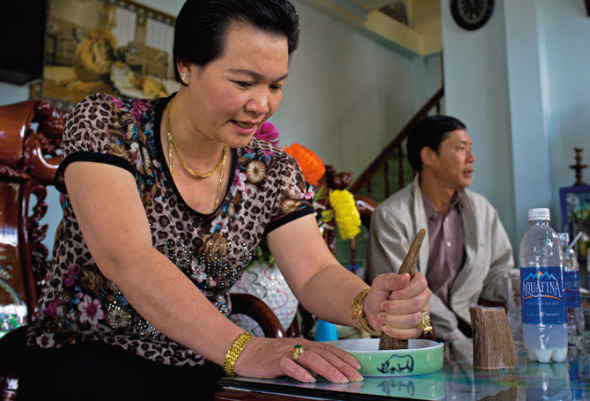
SHOULD VIET NAM BE SLAPPED WITH FULL TRADE SANCTIONS?
Since 2012 International Animal Rescue Foundation Africa’s (Cyber and Environmental Crimes Team) have been investigating Viet Nam’s illicit and illegal wildlife trade more closely than we’ve ever done. Back in January 2015 I Dr Jose C. Depre the (CEO) ordered a meeting with both units from the Environmental Cyber Crimes Team and External Affairs Unit); both focusing on the ground and online trade of illegal wildlife contraband. My aim was to increase both online and ground team investigations to begin breaking the back of these ruthless criminals throughout Asia and Africa.
International Animal Rescue Foundation Africa since founded have conducted 1,033 investigative surveys relating to all areas Viet Nam’s illegal wildlife trade (online and ground trade). However it wasn’t until January 2015 after uncovering a colossal rhino horn trafficking ring within Thailand and Viet Nam that we eventually decided Viet Nam had to be investigated more in-depth - all of which has resulted in a number of arrests and confiscation orders this year alone. The ongoing investigation was ordered due to a suspicion that the illicit ivory trade was increasing in Viet Nam too. Furthermore various organisations, media and press had stated that Viet Nam’s wildlife trade was actually decreasing, neither of which was true!.
I.A.R.F.A’s investigations aren’t just focused on Viet Nam. Specialist teams locate traffickers, suppliers and even poachers. These highly trained investigative officers move from one country to the next discretely monitoring and following various traffickers and kingpins (not forgetting befriending others too - which in many cases can be quite dangerous). While most of our investigations have focused primarily on Viet Nam, China, Thailand, Laos, Japan and Malaysia. Investigative officers have also been working within Uganda, Angola, South Africa, Namibia, The Democratic Republic of the Congo, South Sudan, Niger, Nigeria and Burkina Faso (among many other countries).
In four days time South Africa will be hosting the next Conference of Parties (CoP17). The Convention on International Trade in Endangered Species of Wild Flora and Fauna (CITES), that now hosts some 184 CITES signatories which will be debating numerous issues relating to both flora (plants) and (fauna) animals. The meeting will take place from the 24th September to the 5th October (2016). Back in 2011 Interpol estimated the extent of the illegal wildlife trade between $10 billion and $20 billion per year. This figure has gradually increased since 2014.
The illegal wildlife trade isn’t confined to just one country. Many countries around the world host wildlife trafficking and dealing routes extending to every continent. Conservationists say the problem is most acute in Southeast Asia. There, trade linkages to key markets in China, the United States, and the European Union; lax law enforcement; weak border controls; and the perception of high profit and low risk contribute to large-scale commercial wildlife trafficking. The ASEAN Wildlife Enforcement Network (ASEAN-WEN) ASEAN Wildlife Enforcement Network, supported by the U.S. Agency for International Development and external funders, is one response to the region’s illegal wildlife trade networks.
Figures from 2014-2015 have shown a startling increase relating to the funds generated from the illegal wildlife trade. Today illegal wildlife trade is estimated to be worth US$50-150 billion per year. The global illegal fisheries catch is valued at US$10-23.5 billion a year and illegal logging, including processing, at US$30-100 billion. (Source: Illegal Wildlife Trade 2014-2015). So as one can see no matter how many meetings we’ve been holding the illegal wildlife trade is skyrocketing to levels that we’ve never seen before. The question is though, how do we as environmentalists stop this, how can we force violating countries to take notice?
International Animal Rescue Foundation Africa have been calling on CITES for more than five years now to impose trade sanctions against offending countries. Unfortunately CITES and their signatories haven’t in our opinion taken a blind bit of notice, especially when it comes to Viet Nam that has been blacklisted as ‘possibly the largest threat to global wildlife on the planet?’. A trade sanction (which is what we want placed against Viet Nam and other offending countries) is a trade penalty imposed by one nation onto one or more other nations. Sanctions can be unilateral, imposed by only one country on one other country, or multilateral, imposed by one or more countries on a number of different countries. Often allies will impose multilateral sanctions on their foes.
From 2015 we (the organisation) have located a staggering $13.5 million (USD) of illegal wildlife contraband - most of which is being traded online via various forums such as Facebook within secret groups. (You can view a some of the contraband we investigative via our Facebook page here). On speaking to numerous traders to try and understand why this trade was being conducted on line; the traders have always stated: (Its more safer to trade, they can trade to a wider market without the need to carry their products over many miles. Finally, its quicker to trade into large private buy and sell forums anything that would be deemed ‘hot to handle’ such as Rhinoceros horn, elephant ivory, and pangolin parts (Etc).
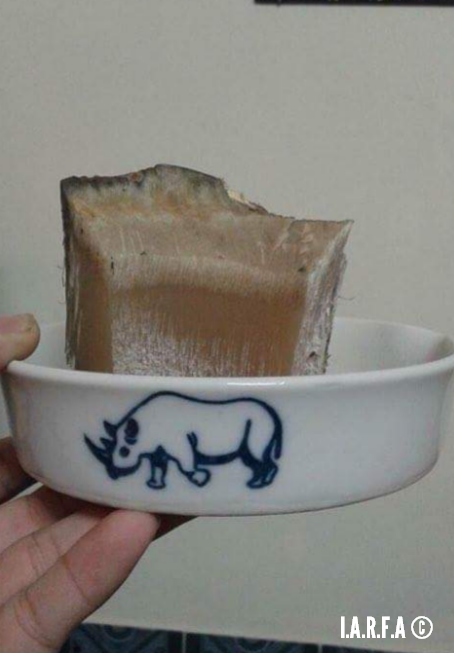
Image: Mr Tuan advertises the authenticity of recently smuggled rhino horn 11th August.
I.A.R.F.A have located over 21 African Rhinoceros horns traded illegally online and via ground markets since 2015 when we began our new anti wildlife trade operations and, 9 Indian One Horned Rhinoceros horns (all authentic). Mr Tuan, a Vietnamese national had no qualms whatsoever proving the legitimacy of his recently smuggled horn from South Africa. Anti Wildlife Trade Officers were invited to Mr Tuan’s Hanoi antiques shop of which in the back room were four recently poached Rhinoceros horns. I.A.R.F.A Anti Wildlife Trade Officers posing as interested buyers were offered the above in liquid form as a ‘so called aphrodisiac’.
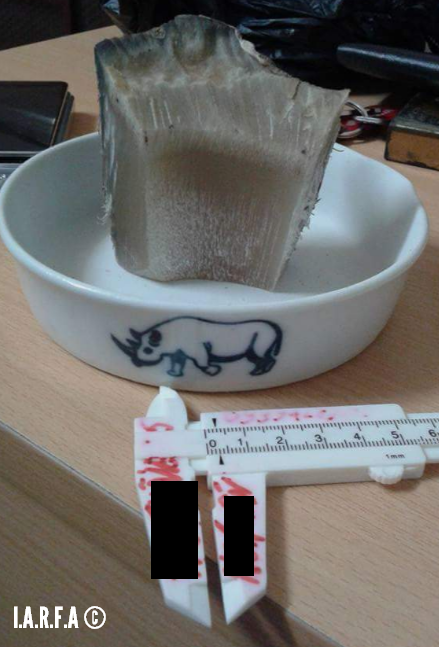
Image: Mr Tuan prepares to sell this horn to I.A.R.F.A investigators.
The above horn was measured up, weighed and offered to I.A.R.F.A investigative officers for a total of $4,000(USD). While the officers declined a small sample was purchased so that we could test the authenticity of this horn. Vietnamese investigative officers working with (I.A.R.F.A) the very next day took the sample to Viet Nam National University of which tests later revealed the horn originated from an African Rhinoceros based on the horns DNA.
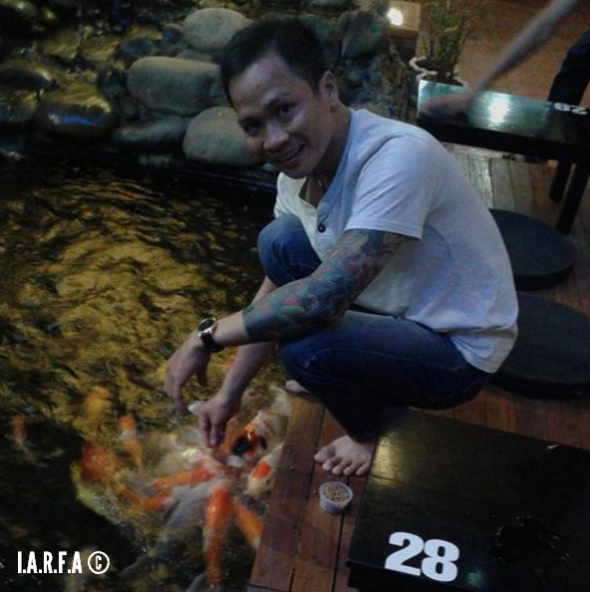
Image: One of Viet Nam’s many Rhino horn kingpins. Mr Tuan.
While we don’t make a habit of exposing ‘wealthy wildlife trade kingpins’. As we’re nearing the (CoP17 summit) we believe its time to begin naming and shaming some of the dons behind this ruthless trade in order to communicate our message far and wide to all CITES members that enough is enough, sanctions must be placed against all violating countries. Mr Tuan doesn’t just deal in large quantities of authentic Rhinoceros horn neither. Ivory, pangolin parts and the critically endangered Indochinese Box Turtle also fill Mr Tuan’s home and antiques shop. So Mr Tuan if you’re reading please do say cheese.
Meanwhile Mr Tuan is just a small piece of the ever-increasing illegal wildlife trade iceberg. In one group that we’ve been monitoring for over two years that’s yielded 9 arrests thus far this year (which we cannot name for legal reasons). Some 33,000 individuals all over the globe are trading ivory, tiger parts, bear claws, pangolin scales and critically endangered moon bear skins (among many other items). The vast majority of these online traders that lead investigative officers to some ground locations are either Vietnamese, Chinese, Malaysian, Indonesian, Indian, Belgium, Australian, American and Canadian traders. One trader was even located in London W12, and two others dealing from Paris, France.
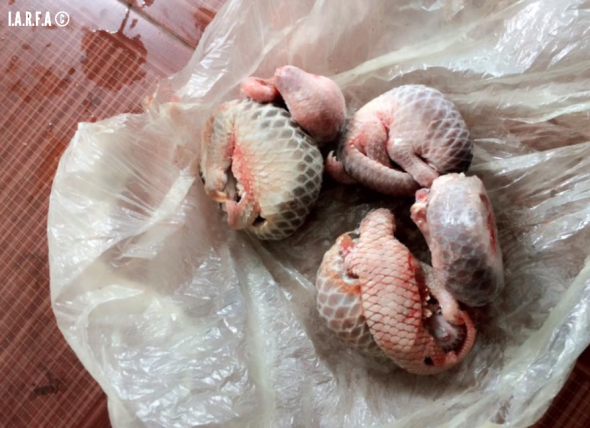
Image: Thailand smuggled endangered pangolins.
Rhinoceros horn is the least likely wildlife trade product that we come-by, simply because of its price, rarity, and the fact so many people around the globe are now putting their foot down relating to this animal part. Unfortunately its not just Rhinoceros horn that we witness being sold illegally online and on the ground. Mr Tu Su whom lives in Ha Tan, Viet Nam was clocked on the 19th August 2016 trading these smuggled pangolin parts online illegally.
Every year there are numerous arrests throughout Asia and convictions relation to pangolin poaching and trafficking, however no sooner is one dealt with - another smuggler and trader rears their ugly head, and can you blame them? All four Asiatic pangolins are now considered extremely rare to the point they’re nearing extinction. Furthermore as the species becomes more rarer - prices increase. These 6 pangolins were trading between $600(USD) and $1000(USD) each. Mr Tu Su has has quite a reputation relating to pangolin smuggling - so for the record below is Mr Tu Su’s face.

Image: Mr Tu Su - Pangolin smuggler and trader.

Image: Mr Tu Su - Pangolin soup.
All 8 species of Asian and African pangolins are ‘listed under Appendix II of CITES’, which means trade is regulated and monitored under CITES, (permits are required from exporting countries for any trade activity). To issue a permit, the exporting country must determine that this activity will have no detriment to the wild population.
As an additional protective measure, the CITES authority passed a (zero export quota for the four Asian species, which bans all commercial trade in these species). However, other purposes (scientific, research, etc.) can still be authorized by permit. For the four African species, there is no zero export quota, which means commercial trade is not prohibited, but permits are still required. Pangolins are also protected in their range states by domestic wildlife laws.
So Mr Tu Su if you’re reading then please note you’ve violated both domestic and international law, we’re holding your details too!
International Animal Rescue Foundation Africa have increased investigations relating to the illicit wildlife trade. Our two main areas of focus is that of the Rhinoceros horn trade and the ivory trade. Since 2015 our investigations surrounding the illegal ivory trade (have located a staggering $6 million(USD) of ivory smuggled from Africa into Thailand, China, Malaysia, Singapore and, Viet Nam.
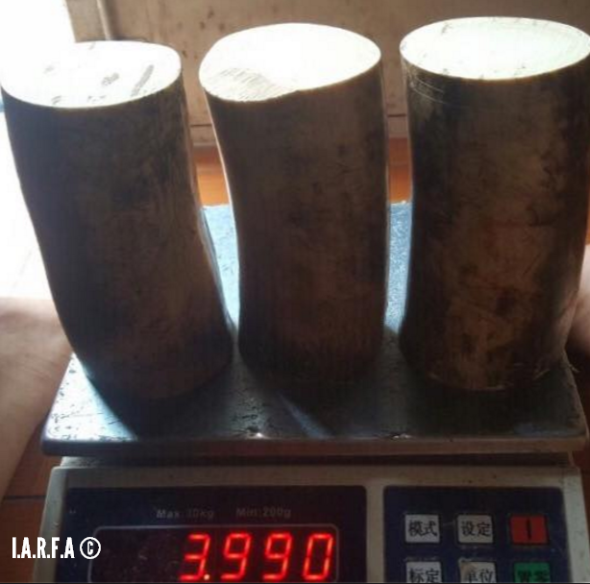
Image: Ivory trafficked from Tanzania onto Viet Nam.
Ivory trader and trafficker Mr Ban Me from Buôn Ma Thuột, Đắc Lắk, Vietnam was observed on the 16th August 2016 trading the ivory above online in one of three secret Vietnamese and Chinese ivory trading online forums. The ivory above is estimated to be around $6,500-$8,000(USD) for the lot.
Mr Ban Me makes no effort to conceal his lucrative online trade neither. When investigating this trader and trafficker we went back through many months of posts within the secret forum, then managed to locate Mr Ban Me who is aged around 35-30 years old. On locating the trafficker/trader it appears from the online evidence that ivory is coming in quick, measured up and weighed, of which either himself or friends then soon after set about to carve the ivory into jewelry.
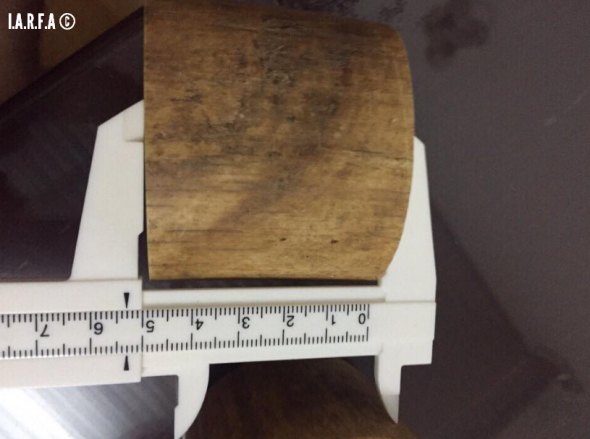
Image: Ivory measured up and weighed for sale and carving.
Since January 2015 (International Animal Rescue Foundations) Environmental Crimes Officers have underneathed new trading trends relating to the ‘online wildlife trade’. As explained in previous articles most traders nowadays will take delivery of illegal wildlife contraband. From there the wildlife parts are then photographed (as seen in the image below). Traders will either then set up a ‘pseudo Facebook profile’ or already have one in place. The Facebook profile will act as a mobile online shop.
Most traders and traffickers we’re investigating today use this method of online illegal trading. They know by using a throw away or cheap (non-traceable cell phone) that any chance of them being located is slim. Traders are rarely seen selling in bulk on the streets of Viet Nam or over the borders in other Asian countries. Buyers and traders feel safer trading, swapping or trafficking items uploaded to the internet.
Mr Ban Me takes delivery of a large quantity of ivory every month from Africa, most of which has been illegally trafficked into China. Once carved the items are then photographed again to sell online within secret trading rooms to hundreds if not thousands of people. The ivory seen above and below was ‘advertised’ to an audience of over 33,000 individuals.
So as you can see its incredibly difficult for us or any investigate organisation to track in quick time where these products are originating from and ending up. Traders use these rooms online because they know selling to a wider-ranged audience products can shift quickly. Unfortunately for Mr Ban Me we have his contact details, his address, his cell phone numbers, and even know who is selling too and buying from.
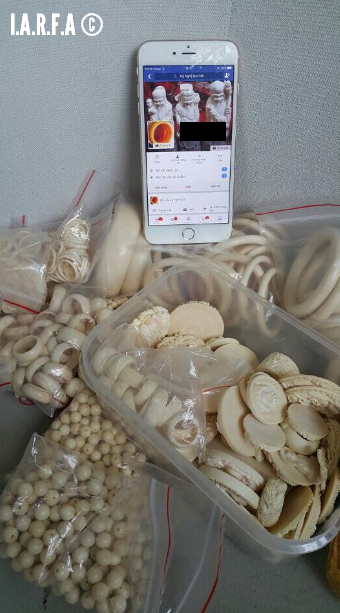
Image: Carved ivory on sale from the tusks observed and intercepted online.
Another shocking ‘concern’ is that Mr Ban Me ‘could be purchasing ivory from Thailand elephant traders’. I.A.R.F.A have known for many years now that ivory tusks are being shaved down from Asiatic elephants. A trace of Mr Ban Me’s cell phone images revealed further evidence that showed himself photographing Asian elephants onto his ‘Facebook ivory profile’. Should this be true - it will prove to be further damning evidence that elephants are being exploited within Asia for the ivory trade on a much larger scale than previously documented.
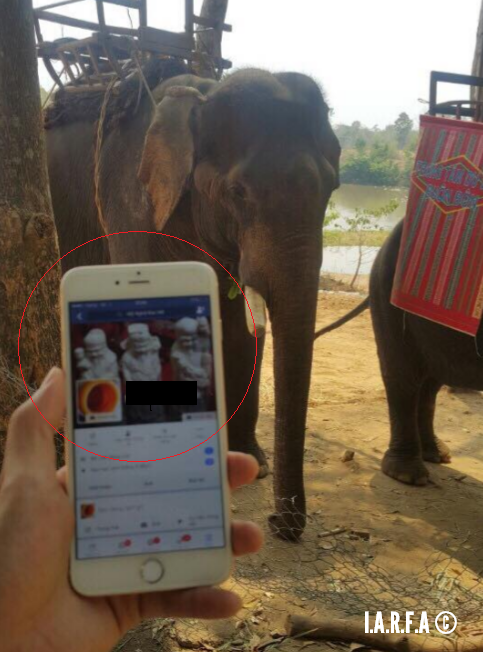
Image: Ban Me photographs Asian elephants onto ivory Facebook profile.
The only image we have of Mr Ban Me is that of his wood workshop in Viet Nam (pictured below). The entire Facebook profile (like many thousands more we have and continue to observe) depicts that of ivory and few rose wood products. The question is though - who’s supplying this young Asian man with ivory? I.A.R.F.A have demanded that Facebook and the F.B.I take action against this illicit trade, and even supplied the Social Media platform with an 11,000+ petition signature however as yet nothing is being done to combat this trade?
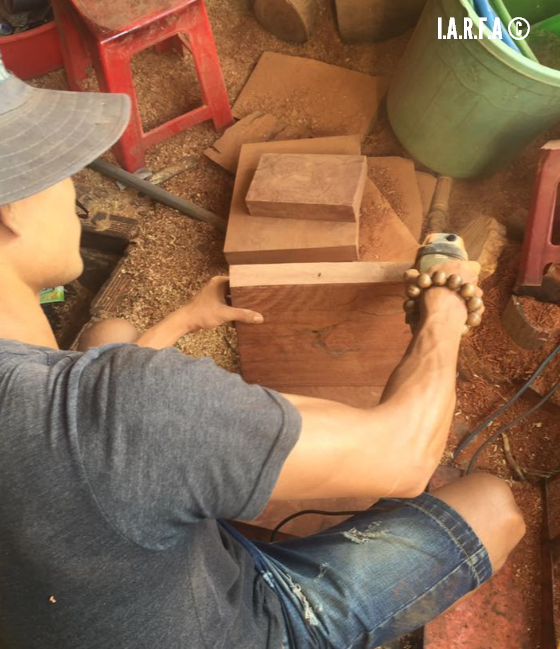
Image: Mr Ban Me carving wood in Viet Nam. where ivory is also traded.
Back in December 2015 International Animal Rescue Foundations (Environmental Crime Officers) passed hundreds of pages of evidence onto international law enforcement agencies and Interpol relating to illegal wildlife traders. There have been numerous arrests due to our investigation and, from that investigation other individuals have been looked into resulting in new investigations and arrests too on a global scale. However no sooner is one trader stopped - another one pops their ugly head up from the sand and begins trading.
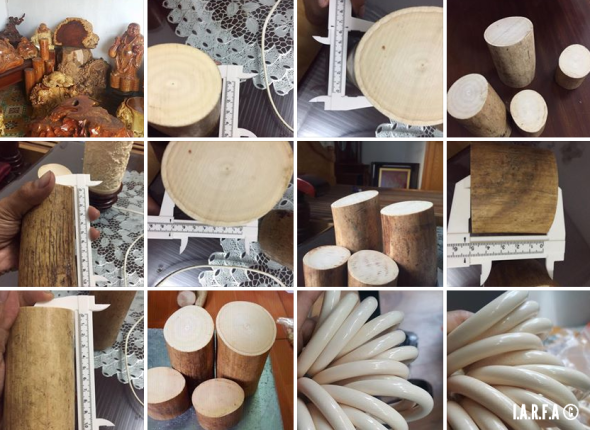
Image: Mr Ban Me’s ivory Facebook shop profile - ivory tusks, and carved ivory jewelry.
A further trader that ‘openly admitted to I.A.R.F.A Environmental Crimes Officers tried to sell these tusks (pictured below) to an I.A.R.F.A investigator. Going under the name of Mr Thường, from Hanoi Viet Nam, he like Mr Ban Me made no effort whatsoever to conceal his hoard of illicit ivory - most of which was from African elephants. Furthermore he too like Ban Me had created a ‘pseudo Facebook profile to trade illegally elephant ivory’.
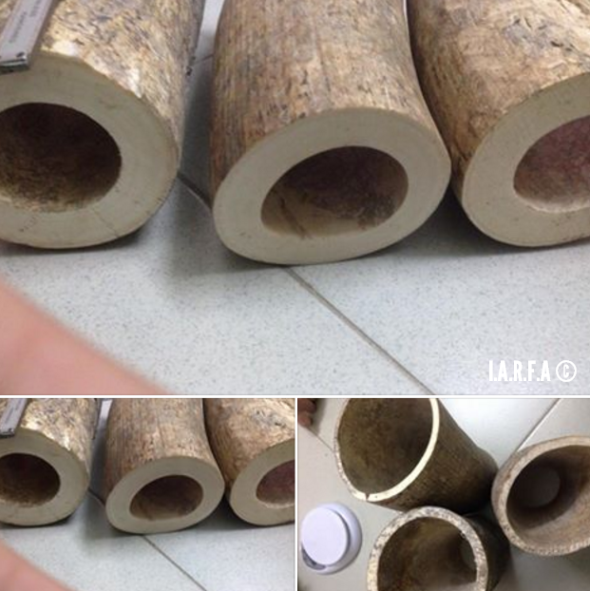
Image: One of many thousands of online Facebook ivory trading profiles.
Viet Nam banned the ‘domestic ivory trade back in 1990’. Furthermore there has been an ‘international ivory trade ban in place since 1989. Unfortunately while these bans have been in place - there are loopholes within some ‘countries domestic trades’ which permits them to trade ‘legally elephant ivory despite international and domestic bans’.
Furthermore ivory can to some extent be sold legally within Viet Nam should the products be antique or purchased before the ivory trade bans. However neither of our investigative officers have located any evidence to prove any of the ivory we’ve located was purchased/obtained legally before any bans were implemented. Damning evidence sent to law enforcement agencies around the globe also proves that ivory is being smuggled from Africa onto Japan and China then back into Viet Nam - Three countries known for their continued ivory trade violations.
While the ivory trade continues to rage out of control there are unfortunately many other illicit and illegal wildlife trades that are increasing within Viet Nam. I.A.R.F.A have noticed a very ‘alarming spike’ of bear parts, mostly moon bears for sale online and on the ground. Environmental Wildlife Crime investigative officers located this species [pictured below] - Ursus thibetanus on the 8th September 2016. The species is identified as the Ursus thibetanus and is listed as [vulnerable] on the (IUCN RED LIST) of threatened and near endangered species.
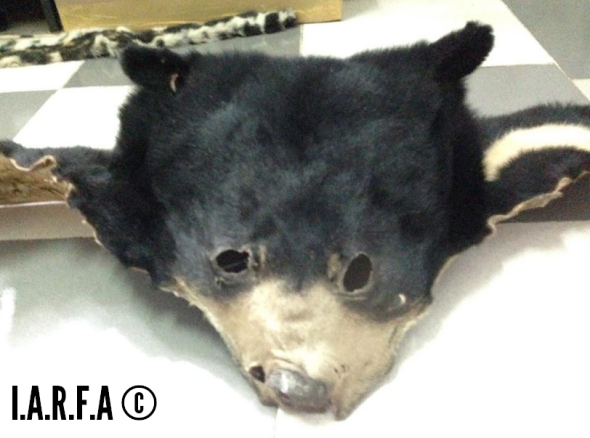
Image: Ursus thibetanus (Moon Bear parts) Viet Nam (2026).
Moon bear pelts, teeth, claws and bear bile are not exactly an uncommon species of animal to be located wihtin Viet Nam’s numerous medicinal markets, although its not common to view the species as it is above on sale within open markets. Bear bile has not decreased in sale on the TCM markets whatsoever in my humble opinion, in fact we (the organisation) hold very recent and damning evidence to prove that bear bile farming practices are sill very much operational. So damning that it does in fact bring many Non Profit Organisations into question with regards to their allegations of practically stopping this trade, when clearly its not being stopped!
Due to many counterfeit animal products on the markets, before any investigation is undertaken - Environmental Scientists will conduct routine examinations of purchased bear bile products to check their authenticity. These examinations are undertaken to store and maintain evidence files, to secure closures of illegal markets or, for further secondary investigations. I.A.R.F.A Wildlife Trade investigative officers located the following bear bile products on the market in Viet Nam.
A kilogram of farmed bear bile might cost $240, while the same amount from a wild bear could cost $15,730. Investigative officers were told the bile seen hereto in the image below was from wild bears, however we highly doubt it due to the lack of Asiatic black bears in the wild. Each bottle below was offered to investigative officers for just over $200(USD). I.A.R.F.A Wildlife Trade investigate officers did purchase three at a price of $600(USD) which is considered cheap. The ‘liquid was tested at the Nong Lam University of which proved to be 100% bear bile.
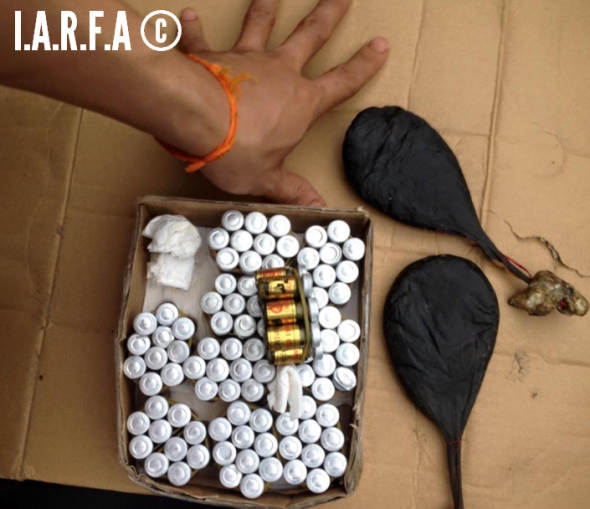
Image: Asiatic Moon bear bile in mass production with gall bladders.
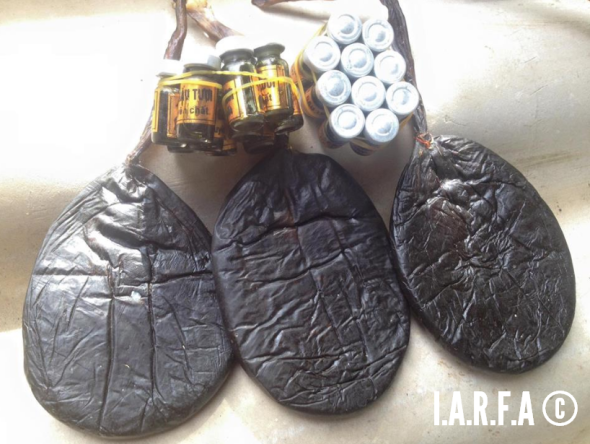
Image: Plastic wrapped gall bladders and bile.
Bear bile does not whatsoever hold any medicinal properties whatsoever, if anything consuming bear bile can actually increase health complaints. The barbaric practice is ‘illegal in China and Viet Nam’, Viet Nam banned bile production back in 1992, sadly the trade still goes on to some extent. Fortunately Viet Nam have stated they’ll be eliminating this horror come 2020, however we’re not holding our breaths just yet.
Mr Nheo who is aged around 21 years of age from the Huong District, living in Hanoi Viet Nam (pictured below) if you’re reading my friend you may want to stop trading pangolins, tiger parts, bear bile, tiger teeth, bear teeth and claws and ivory today. Bear bile hosts no medicinal properties whatsoever so why you’re trading this vile product - which leads to the destruction of bears for we don’t know..

Image: Mr Nheo - Illegal wildlife trader from Hunong District, Viet Nam.
At the last Conference of Parties Summit (CoP15 - Thailand), Viet Nam made a promise to crack down on the countries illegal wildlife trade back in 2013. Although there was no actual deal made, Cites signatories did categorically state that should Viet Nam want any say in the ‘legalized international trade of rhino horn’ the country must clamp down on illegal wildlife trades and markets. I was at the last CoP summit of which Viet Nam agreed it was time to reduce their illegal trade markets - or face the consequences.
The whole purpose of this article and many others is to ‘highlight Viet Nam’s lies; the country hasn’t in my opinion made any progress to reduce their illegal wildlife markets, especially that of (critically endangered species). Yet Viet Nam has been identified as one of the leading countries to be approaching Cites for the ban to be lifted relating to the (international rhino horn trade). I ask myself daily - how is it possible for a country to control any legal trade if they cannot control the illegal trade of wildlife contraband?.
I.A.R.F.A. Environmental Crimes officers working online and on the ground furthermore have noticed a colossal spike in the number of tiger parts and dead tiger carcasses sold within Viet Nam’s illegal wildlife trade markets. The image below depicts a trader that is privately trading tiger teeth. While the quantity of tiger teeth wihtin the image (below) may seem small. I.A.R.F.A Environmental Cyber Crimes officers have been carefully monitoring this trader for well over a year. The vast amount of tiger parts he’s trading is out of this world.
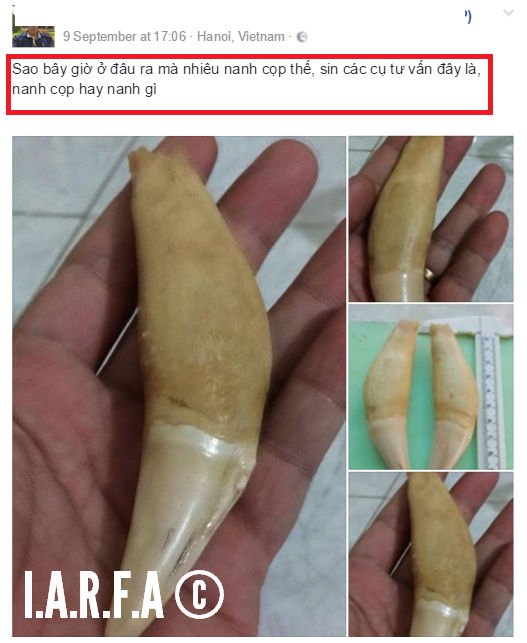
Image: Tiger teeth for sale- Online Secret Wildlife Trading Forum.
I.A.R.F.A have reported various tiger traders in Viet Nam to INTERPOL and local enforcement agencies. However as explained these bloody sickening traders, traffickers and animal killers continue to pop up time again. Most if not all the tigers that we are locating for trade (illegally) were ether captive tigers, smuggled tigers/parts from China and/or Thailand. While other specimens have actually originated from (pathology/veterinary universities inside of Viet Nam).
Three months ago I.A.R.F.A working with overseas enforcement experts concluded - the rare Asiatic leopard we located within a wildlife traders apartment had originated from a veterinary university in Viet Nam. Meanwhile the tiger skins/parts below have originated from Thailand. The question is though from where, who is supplying this amount of tigers and parts to traders within Viet Nam?
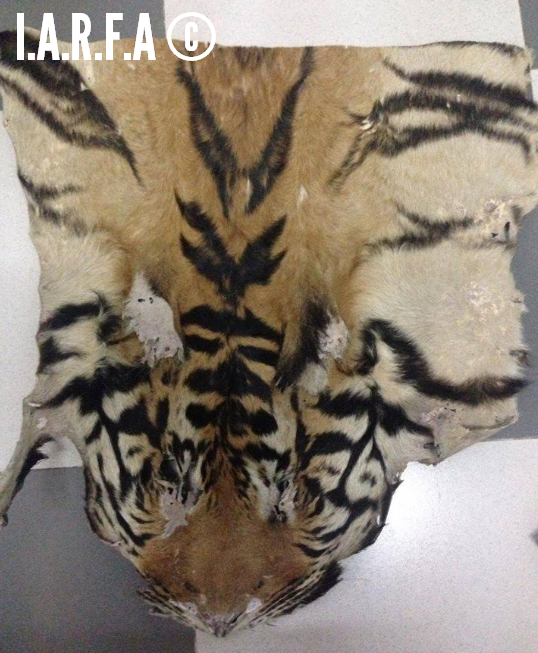
Image: One of many tiger skins offered to I.A.R.F.A investigators September 8th.
International Animal Rescue Foundation Environmental Cyber Crimes Officers was offered this tiger pelt for $1,060(USD). The trader that operates under the name of ‘Mr Coivodich’ also deals in ivory, threatened Rhinoceros hornbills, and bear bile. Furthermore we have been monitoring a very ‘concerning trend relating to tiger skin wallets. Captive bred tigers are slaughtered of which their skins are turned into wallets - a craze that is now becoming incredibly popular throughout Viet Nam. Tigers in Viet Nam are supposed to be bred for conservation purposes only. Clearly though from the images below this is not the case.
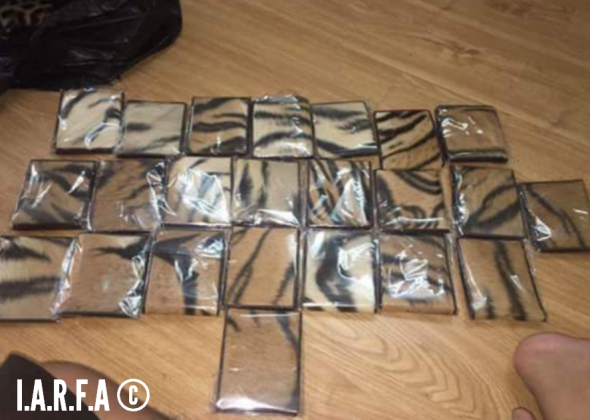
Image: Real tiger skin wallets packaged and ready for sale in Hanoi.
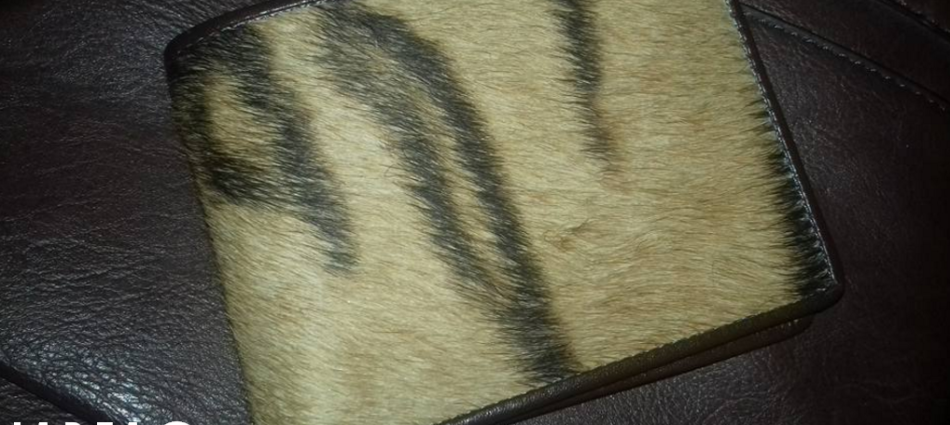
Image: Unpacked real tiger skin wallet, priced at $70.00(USD) each.
As explained tigers are supposed to be used for conservation purposes only. However we have located worrying evidence that makes Tiger Temple look more like a walk in the park. A famous Thailand Actor below is seen cuddling a drugged tiger at the Sriracha Tiger Zoo which we believed was a zoo inside of Viet Nam. (See image below). Unfortunately the tiger and this image eventually led back to Thailand, of which this zoo has been named as a horror ground. Would it be wise to assume that tigers are originating from this zoo and ending up within Viet Nam’s wildlife trade? We don’t know. What we do know for sure though is this zoo is now under close scrutiny.

Image: Chen Yunan coaxes drugged tiger in Thailand.

Image: Ranya Rao coaxing drugged tiger in Thailand.
International Animal Rescue Foundation’s Environmental Crimes teams have been working on our new anti wildlife trade project since 2015 being now the ninth major project that we have conducted in the past three years. Most of the evidence we are locating in relation to wildlife trade violations isn’t always within China - a lot of these violations are in fact within Viet Nam.
We are now under four days away from the next Conference of Parties (CoP17) to be held within South Africa, Johannesburg. CoP 17 has been set to be the largest summit held, and as such we may see countries such as Viet Nam asking Cites signatories to agree to a lift of the international trade ban in Rhinoceros horn. Every article that we’ve published in relation to Viet Nam shows the country cannot be trusted with relation to the international rhino horn trade. Every article we’ve published also shows numerous violations of local and international wildlife trade laws.
So the question remains. Is it now time to implement at CoP17 full part of full sanctions against Viet Nam to protect our local and international wildlife? I believe its now time. The evidence in front of you clearly shows Viet Nam’s refusal to act on their illegal wildlife trade markets. So how much more do we have to put up with before everything is eventually gone? Should Cites signatories lift the rhino horn trade ban we’ll keep to our promise. Being all those we know dealing in illegal wildlife products at high end market level will be named, shamed addresses published and that evidence released to the public. Video recordings, audio, images - everything.
The balls now in Cites court - Don’t underestimate us, we may be quiet - but we’ll stay quiet for only a short time before we begin naming and shaming.
Dr Jose C. Depre. PhD. MEnvSc. BSc(Hons) Botany, PhD(NeuroSci) D.V.M.
Environmental, Botanical & Human Scientist.
VEGAN PAZARTESI | PATATESLI PUF POGACA | TURKISH VEGAN.
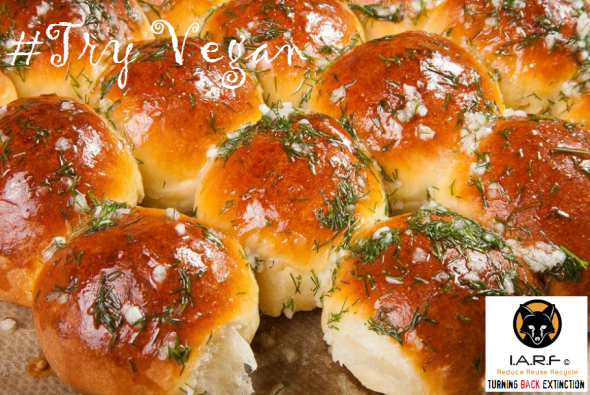
PATATESLI PUF POGACA | TURKISH VEGAN
Your weekly vegan delightful recipe is out, and may I please suggest that you try patatesli puf pogaca which is a stunningly tasty Turkish breakfast roll. When I was last in Armenia I tried this dish fresh from the bakers, and its the most amazing, tasty, filling and aromatic breakfast roll I’ve ever tried. Vegetarians can opt for the potato and cheese variety which normally consists of feta. However as it is, is just divine.
Every Monday and Friday we publish a vegan or vegetarian recipe onto our main news site, as well as publishing everyday onto our Facebook page various recipes for both vegans and veggies. Please note that we do not any longer use the #GoVegan hashtag. Instead the #TryVegan hashtag, simply because Mondays and Fridays are two days of the week that we encourage ‘thousands of our readers around the world to try a vegan non-meat non-dairy recipe’. There’s no harm in that is there? I didn’t think there was!
Patatesli puf pogaca is a traditional Turkish breakfast roll for those on the go or running a busy lifestyle. Furthermore patatesli puf pogaca can be implemented into dinners and snacks, and you can spice it up a tad too if you’re feeling in the mood. A little ginger or all spice at Christmas is also great - only a little though added to the potato. Okay so here’s the recipe and please enjoy, have a nice day, and enjoy the beginning of your week.
INGREDIENTS:
2 cups luke warm water
4-5 cups flour
1 Tbsp instant yeast (1 package)
2-3 Tbsp olive oil
1 Tbsp sugar
1 Tbsp salt to taste
Potato Filling:
2 large or 3 medium potatoes, boiled and smashed
1 onion, chopped
1 tbsp tomato paste
2 tbsp oil (canola/ sunflower/vegetable/corn/olive)
½ tsp salt
¼ tsp cayenne pepper (optional)
¼ tsp black pepper
¼ tsp cumin (optional)
(NB: If you are allergic to gluten then please opt for the gluten variety ingredients for your fresh bread).
RECIPE:
In a pot boil the potatoes and smash them. Meanwhile in a pan place the oil and onion, and sauté for 2-3 minutes on low-medium heat. Then add the tomato paste, salt and smashed potatoes. Cook for 5-6 minutes stirring occasionally. Finally sprinkle with pepper, cumin and cayenne pepper.
Glaze:
Glaze:
VEGAN: (AGAR AGAR) (There are other substitutes for egg yolk please click here for more information)
1 tsp water
Sesame seeds for top
(NB: If you’re not a vegan you can use one egg yolk, 1 tablespoon of water and sesame seeds on top)
Place the lukewarm water, sugar and the yeast into a bowl. Stir well to dissolve the sugar and the yeast. Add salt, olive oil and flour; knead for 10 minutes, until dough becomes elastic. The more you knead the better your dough will be. Cover the dough with a plastic wrap or a clean cloth, and let it rest for 2 hours in a warm place, till it rises up to double its volume.
Place dough on the counter and punch to release the air. Cut the dough into 20-22 pieces. Flatten each of the pieces with your hands and place 1 Tbsp or more potato filling in the middle and close it up sticking well the ends. Grease a baking dish and place the puff pogacas over, stuck ends being down, leaving some room between each. Cover it with a clean cloth and leave it for ½-1 hours to rise in a warm place (If you have time let it rest for 2 hours).
Mix the AGAR AGAR or if veggie beaten egg yolk and water in a small bowl, then brush the surface of the puff pogacas with this glaze. Finally, sprinkle sesame seeds on top.
Preheat the oven to 400F (200C). Bake for 30-40 minutes, until it becomes golden brown. Take it out of the oven and cover with a clean cloth or towel to keep them soft and warm.
(NB: Do not use metal container when kneading or resting the dough. Metal spoils the texture of dough).
These savory bread rolls are very easy to make, may I suggest if cooking for breakfast that you prepare the dough before bed and leave the dough within an ambient room. Shelf life NO MORE THAN 4+ HOURS due to the potato. You can reheat however they are best served fresh. Yes breakfast can be time consuming however why not make them on a Sunday, or for a snack, you can prepare this wonderful Turkish delight anytime you want too. I’ve included the option for both vegan and veggie as I believe its fair.
(NB: As with all recipes I or others from our main cooking page print - if you suffer from cardiovascular disease, have a history of stroke or are taking sodium based medications then please opt for the low sodium salt. There are alternatives for salt although I myself have never tried them and I’m not sure if these will work in the prepping process of this bread. However you can read more here
Below are two videos. 1. The vegan method, however I still advise to try the above recipe as its no different really to the vegan (Turkish recipe). 2. The Turkish recipe. (PLEASE NOTE VIDEO [2] IS NOT VEGAN). Video [2] is the Turkish traditional recipe though with cheese and potato.
That’s it folks and have a nice day.
Dr Jose C. Depre.
Environmental, Botanical and Human Scientist.
ENDANGERED SPECIES MONDAY | PHOCARCTOS HOOKERI EXTINCTION LOOMING - NATIONAL EMERGENCY.
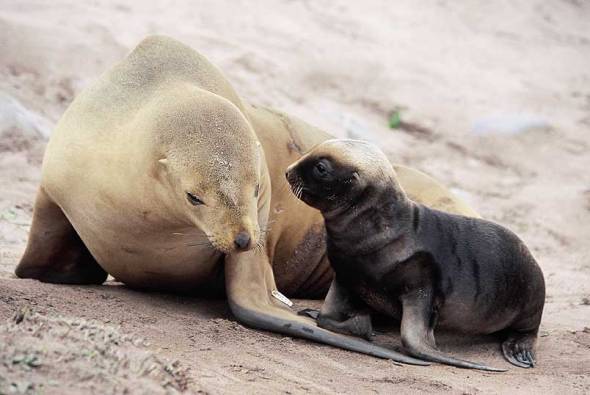
ENDANGERED SPECIES MONDAY | PHOCARCTOS HOOKERI
This Monday’s endangered species (E.S.P.) article I’ve chosen to document on the New Zealand sea lion. Image: New Zealand Sea Lion. Credits: Tui De Roy.
Listed as (endangered) the species was identified by Dr Gray back in 1866. Dr Gray John Edward Gray, FRS (12 February 1800 – 7 March 1875) was a British zoologist. He was the elder brother of zoologist Dr George Robert Gray and son of the pharmacologist and botanist Dr Samuel Frederick Gray (1766–1828).
Dr Gray was Keeper of Zoology at the British Museum in London from 1840 until Christmas 1874, before the Natural History holdings were split off to the Natural History Museum published several catalogues of the museum collections that included comprehensive discussions of animal groups as well as descriptions of new species. He improved the zoological collections to make them amongst the best in the world.
Scientifically identified as the Phocarctos hookeri the species was listed as vulnerable from 1994-2008. Unfortunately due to continued population declines the New Zealand seal is now bordering complete extinction within the wild (and things really aren’t looking good neither) Endemic to Australia (Macquarie Is.); and New Zealand (South Is.), the species is also native to the Pacific North West.
To date there is estimated to be no fewer than 3,031 mature individuals remaining within the wild. New Zealand sea lions are one of the largest New Zealand animals. Like all otariids, they have marked sexual dimorphism; adult males are 240–350 cm long and weigh 320–450 kg and adult females are 180–200 cm long aMnd weigh 90–165 kg. At birth, pups are 70–100 cm long and weigh 7–8 kg; the natal pelage is a thick coat of dark brown hair that becomes dark gray with cream markings on the top of the head, nose, tail and at the base of the flippers.
Adult females’ coats vary from buff to creamy grey with darker pigmentation around the muzzle and the flippers. Adult males are blackish-brown with a well-developed black mane of coarse hair reaching the shoulders. New Zealand sea lions are strongly philopatric.
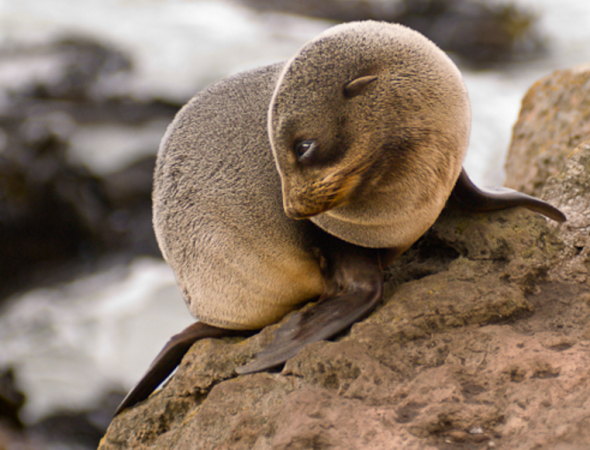
Image: New Zealand Sea Lion Pup. Credits: NZ Fur Seals.
Back in 2012 populations of New Zealand sea lions “were estimated to be standing at a population count of 12,000 mature individuals”. However since that count took place, from (2014) populations have ‘allegedly plummeted’ to all new levels although there doesn’t appear to be any evidence as to why the species suddenly declined - fish trawling and disease have been noted though!.
Like the Maui’s dolphin, the sea lion has come under intense scrutiny this year after research showed its numbers had halved since 1998. It has been classed as nationally critical and if its decline is not stemmed will be extinct within 23 years. A bacterial infection severely reduced breeding in 1997-98, and the species has failed to recover.
Its decline has been compounded by deaths due to squid fisheries, which trawl at a similar depth to the sea lions’ hunting grounds. Conservation groups call the population decline “a national emergency and are calling on stricter by-catch limits and a change in fishing methods”.
BACK IN 2012 THE NEW ZEALAND HERALD REPORTED THE FOLLOWING
In a country with 2800 threatened species, conservation in New Zealand is often about picking winners. The Department of Conservation’s budget and energy can extend only to active interventions for 200 of these endangered species.
Whether a species is protected depends on funding, community input, national identity and research. DoC spokesman Rory Newsam says interventions are often made because the department believes it can “get the most bang for its buck”. But animals and plants are not always invested in because they have a greater chance of survival.
The kakapo receives a relatively large chunk of funding despite being functionally extinct on the mainland. Some ecologists argue too much is spent rescuing the rare parrot, while more crucial parts of our ecosystem are left behind. But the kakapo is protected because it is a charismatic species and the public considers it integral to New Zealand’s ecological identity.
Conservationists say kakapo are a window to New Zealand’s history. They are believed to have inhabited the Earth for millions of years. To kill them off in a fraction of that time is an indictment on the way we live.

Image: New Zealand Sea Lion. Image Credits One Newz.
New Zealand sea lions are known to predate on a wide range of prey species including fish (e.g. hoki and red cod), cephalopods (e.g. New Zealand arrow squid and yellow octopus), crustaceans, seabirds and other marine mammals. Studies indicate a strong location effect on diet, with almost no overlap in prey species comparing sea lions at Otago Peninsula and Campbell Island, at the north and south extents of the species’ breeding range. New Zealand sea lions are in turn predated on by great white sharks, with 27% showing evidence of scarring from near-miss shark attacks in an opportunistic study of adult NZ sea lions at Sandy Bay, Enderby Island.
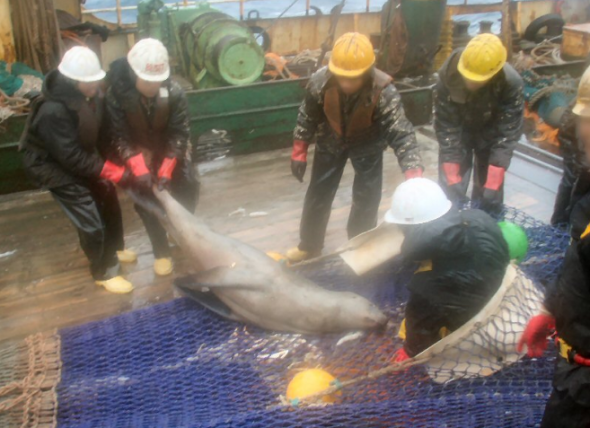
Image: Dead New Zealand Sea Lion in Fishing Net.
Since 2012 New Zealand conservationists, and the public community have been calling on the New Zealand government to do everything they possibly can to preserve this species. Unfortunately as you can see above fishermen are still accidentally killing the species off. As the species is protected under law and listed as endangered, the New Zealand government must take action against these perpetrators, otherwise extinction will most certainly occur.
The Maori people of New Zealand have traditionally hunted Sea Lions, presumably since first contact, as did Europeans upon their arrival much later. Commercial sealing in the early 19th century decimated the population in the Auckland Islands, but despite the depletion sealing continued until the mid-20th century when it was halted.
Commercial sealing in the early 19th century decimated the New Zealand Sea Lion population in the Auckland Islands, but despite the depletion sealing continued until the mid-20th century. The population has yet to fully recover from the period of over exploitation. At the present time, New Zealand Sea Lions have a highly restricted distribution, a small population, and nearly all of the breeding activity is concentrated in two subantarctic island groups. This restricted and small breeding population in combination makes them vulnerable to disease outbreaks, environmental change, and human activities.
The commercial Arrow Squid trawl fishery near the Auckland Islands reported their first New Zealand Sea Lion bycatch mortalities in 1978. Reported or estimated mortality between 1995 and 2007 averaged 92 animals annually (range 17-143) which was 3.7% of the estimated number of mature individuals in the Auckland Island area. Of particular concern is that most bycatch animals are females (up to 91%). New Zealand Sea Lions are also incidentally caught in other trawl fisheries around the Auckland and Campbell Islands.
Apart from direct mortality, competition and habitat modification caused by fishing activity may also be impacting New Zealand Sea Lion foraging areas. Epizootic outbreaks at the Auckland Islands in 1998, 2002, and 2003 led to more than 50%, 33%, and 21% early pup mortality respectively, and were also responsible for the deaths of some animals from other age classes during 1998.
The source of the suspected bacterial agent and cause of the outbreak and subsequent mortality for the 1998 outbreak are unknown, however the 2002 and 2003 outbreaks have been identified as being caused by Klebsiella pneumoniae.
The future of the New Zealand sea lion doesn’t look good at all. I highly suspect that we’re going to lose the species within 10-20 years (if that). More needs to be done to preserve the species habitat and its current fishing grounds as well as protecting from bacterial outbreaks. Failing this the species will be extinct within 10-20 years max. I am highly doubtful here, which is very rare for me to speak about.
Thank you for reading.
Dr Jose C. Depre. PhD. MEnvSc. BSc(Hons) Botany, PhD(NeuroSci) D.V.M.
Environmental, Botanical & Human Scientist.
CAULIFLOWER & OYSTER MUSHROOM TACOS | VEGAN FRIDAY - #TRY VEGAN.
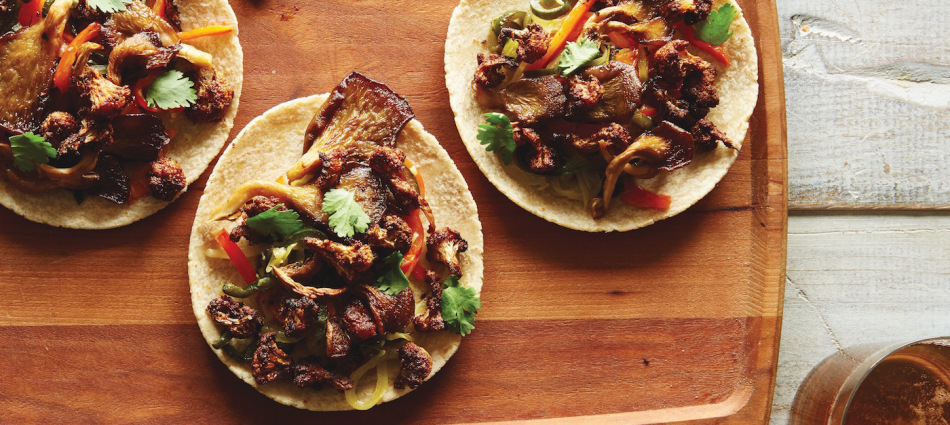
SPANISH CAULIFLOWER & OYSTER MUSHROOM TACOS
Your #TryVegan Friday recipe is now out. We’ve opted for something different to show our readers this week. I made this dish late July, not being a great fan of tacos however a massive fan of mushrooms. Added to the taco and with the cauliflower this dish is outstanding, furthermore with the summer kind of still with us in Europe - this dish would make a great accompaniment to any party or guest get together.
Every week we publish on our main site here a vegan Monday and vegan Friday dish. Furthermore on our Facebook page we publish every day a vegan or vegetarian recipe for hundreds of thousands of our viewers globally. Finally please don’t forget that our (#TryVegan) Monday and Friday dishes are aimed at those that are still thinking of going meat and non-dairy free but not sure. So why not try two days a week with a tasty vegan or veggie recipe, and if you don’t like it, well, at least you’ve tried.
INGREDIENTS:
1 head cauliflower (cut into small florets, 6 to 8 cups/600 to 800g)
4 tbsps olive oil
1 tbsp chili powder
1 tbsp smoked paprika
1 tsp ground coriander
2 tsps ground cumin
1 pinch red pepper flakes
salt (Please leave the salt out of childrens receipes, and anyone that’s taking ‘sodium based mediciations’)
pepper
1 cup vidalia onion (thinly sliced)
1 poblano chiles (large or 2 small, thinly sliced)
2 cups red bell pepper (chopped)
1 clove garlic (minced)
6 ozs oyster mushrooms (thinly sliced)
2 tsps lime juice (freshly squeezed)
8 corn tortillas (6-inch/15cm crisp)
2 cups chopped fresh cilantro (for garnish)
RECIPE:
Preheat the oven to 425°F (220°C). In a large bowl, toss the cauliflower florets with 2 tablespoons of the olive oil until evenly coated. Sprinkle with the chili powder, paprika, coriander, cumin, red pepper flakes, and a generous pinch of salt. Toss again until the cauliflower is evenly coated. Spread the cauliflower on a rimmed baking sheet. Bake for 20 minutes, until crispy. Heat the remaining 2 tablespoons of olive oil in a large skillet over medium heat. Add the onion, poblano, and red bell pepper and sauté until the onion is tender and a bit golden, about 15 minutes. Add the garlic and sauté for another minute. Stir in the mushrooms, then season with salt and pepper. Cook until the mushrooms are tender and crispy (5 to 8 minutes). Remove from the heat and stir in the lime juice. Taste and adjust the seasonings as desired. For each taco, put ¼ cup (60ml) of the mushroom mixture in a tortilla. Top with some of the roasted cauliflower and a tablespoonful of cilantro. Enjoy
Thank you and have a great weekend. Don’t forget to check the ‘vegan sweet dish out below’.
Dr Jose Depre.
ENDANGERED SPECIES FRIDAY | EQUUS FERUS CABALLUS | WILD HORSES OF NAMIBIA.
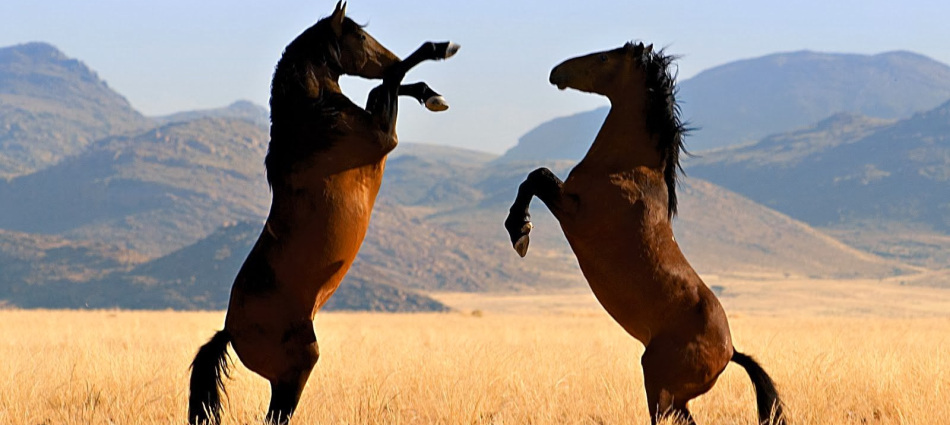
ENDANGERED SPECIES FRIDAY | EQUUS FERUS CABALLUS
This Fridays Endangered Species Post focuses on a sub species of the E. ferus that inhabits the plains of Namibia, Africa. Image: Klein-Aus Vista - E. F. Caballus.
The species (E. ferus) I believe was identified by Professor Carl Von Linnaeus back in 1758 of which identified quite a large number of horses to be precise, however the E. F. Caballus originates from around 1915. Carl Linnaeus born (23 May 1707 – 10 January 1778), also known after his ennoblement as Carl von Linné was a Swedish botanist, physician, and zoologist, who formalised the modern system of naming organisms called binomial nomenclature. He is known by the epithet “father of modern taxonomy”. Many of his writings were in Latin, and his name is rendered in Latin as Carolus Linnæus (after 1761 Carolus a Linné).
E. F. Caballus isn’t listed on the IUCN Red List that I myself can locate (although is endangered). From 1965 the species was listed as (incredibly rare). Then ‘sketchy reports’ state from 1986 to 1996 the species went completely extinct within the wild, there is no evidence to back this claim up though.
From 2008 the species was ‘allegedly’ re-discovered and listed as critically endangered (although as explained there is no criteria on the IUCN Red List relating to this sub-species). Come 2011 populations had somewhat increased slightly placing the species in the band of endangered?. The criteria relating to extinction I am currently looking into as I believe this report ‘could be incorrect’. There is certainly some image evidence (although not proven) that shows a species ‘identical to the Namibian horse’ during the so called extinction period from 1986-1996. However the sub-species has been reported on since the 1940’s.
From what I know the species is a rare feral desert horse of which populations are believed to be near extinction level. Populations are estimated to be between 90-160 mature individuals. Namibia wild horses generally lead healthy life’s although during times of extreme drought (during the summer months) is when the species is normally reported to be struggling, with a number of deaths reported annually.
The origin of the Namib desert horse is unclear, though several theories have been put forward. Genetic tests have been performed, although none to date have completely verified their origin. The most likely ancestors of the horses are a mix of riding horses and cavalry horses, many from German breeding programs, released from various farms and camps in the early 20th century, especially during World War I. Whatever their origin, the horses eventually congregated in the Garub Plains, near Aus, Namibia, the location of a man-made water source.
During the 1980’s the species was virtually eradicated because locals disliked the horses trampling and eating their crops. Fortunately up until the 1980′ the species has lived a virtually hassle free life. Humans rarely if at all bother them, and there is no evidence to prove the species is under threat from hunters, or the African medicine/animal parts trade. Furthermore there doesn’t appear to be any evidence of poaching neither which is good.
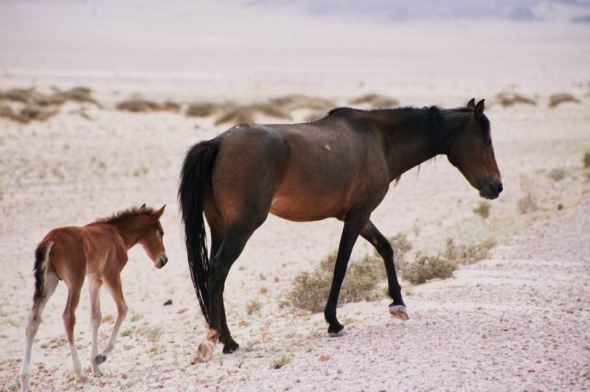
Image: Namibia desert horse and foal.
Namibian wild horses host a number of ‘wild predator threats’ though such as hyenas, blacked backed jackals, and leopards too. Young horses (foals) are normally taken by predators, however adults rarely aren’t.
The harsh environmental conditions in which they live are the main driver of mortality among the Namib desert horse, as they cause dehydration, malnutrition, exhaustion and lameness. Other large plains animals, including the mountain zebra, may have once sporadically utilized the area for grazing during periods of excess rainfall, but human interference (including fencing off portions of land and hunting) have eliminated or significantly reduced the movement of these animals in the area.
The endangered Hartmann’s mountain zebra does exist in the Naukluft Mountain Zebra Park portion of the Namib-Naukluft Park, but their range does not intersect with that of the Namib Desert Horse.
SOURCE: HORSE JUNCTION.
From what I know there is no evidence of wild horses inhabiting anywhere within ‘Southern Africa’, so the theory is these horses may have been imported by the Germans during the last World War, of which after the war the horses were eventually set free to do as they please. While there are numerous speculations and stories - we’ll never truly know where these horses have originated from. Furthermore due to interbreeding genetic testing has proven to be somewhat of a failure too in establishing the true origins of these magnificent beasts.
SOURCE HORSES AND GHOST TOWN CNN.
A further theory although not proven touches on a large vessel carrying thoroughbreds to Australia that unfortunately wreaked near the Orange River. On breaking up the strongest horses are ‘believed’ to have swam ashore to the Garub Plains, the home of the Namib Desert Horse, near Aus, Namibia. As explained though to date there is still no evidence to prove where these horses originated from, moreover all theories haven’t a single scrap of evidence to back such claims up.
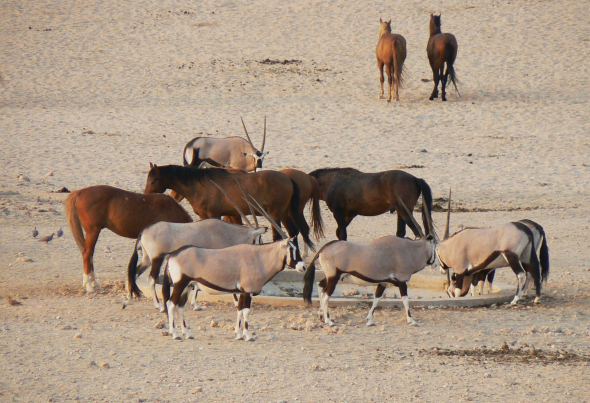
Image: Namibia wild horses drinking at water hole.
One of the biggest threats that could today threaten the wild horses of Namibia is that of water shortages. For now we know the horses normally occupy areas where there is sufficient water holes, large man-made or natural lakes. With drought and climate change becoming more problematic within many Southern African countries its likely we ‘could see species extinction occur in as little as five to ten years’.
All the wild horses in the world, with the exception of a single population, originate from domestic stock. Horses were domesticated on the Eurasian steppes 5,000 to 6,000 years ago, and have been in service to humankind ever since. It was on the horse’s back that civilization advanced. Countries were explored, wars were fought, agriculture and industry progressed at the expense of the horse’s freedom.
The only horse population that was never domesticated, and still exists in its true genetic form, is Przewalski’s Horse or the Mongolian Wild Horse. So extinction could occur very soon simply because the Namibia wild horse’s natural born living instincts haven’t really adapted to the extreme wilds of Africa hence why they are commonly located around man-made or natural water sources, and human settlements?
It was reported this year back in April that drought has been responsible for many species of animals dying due to lack of water and available fresh food sources which has prompted the Namibia Wild Horses Foundation (NWHF) to appeal for funds or good quality grass during this more severe period to see the horses through the winter. NWHF was established in 2012 to monitor the well−being of the horses and to marshal funds for buying feed when the need arises during the drier cycles.
Back in April (2016) the (NWHF) stated there is little grass in the horses’ range as the drought has severely affected the central and southern parts of the country. “The foundation fears that without rain there will be virtually no grass left by the onset of winter and as the horses’ condition further deteriorates, numbers will begin to drop dramatically,” the statement reads. Spring is also now approaching Africa of which we may see further prolonged droughts, and even more deaths.
The foundation also expressed gratitude for all generous contributions for the horses during the past six months. This, it said, has provided supplementary feed – a quarter to a third of the horses’ nutritional requirements — in the form of grass and lucern and protein licks, and will sustain the herd until the beginning of June when the next phase will need to be implemented to ensure their survival; (this period is now over and donations are greatly needed to keep these horses alive). If you’d like to donate to the (NWFH) please click the donate button here: DONATE.
Concerning: The April report also highlighted that some 100 ‘old horses and some fouls’ had sadly perished since the beginning of the drought, which to date leaves exactly 160 mature individuals remaining within the desert of Namibia.
Donations to buy grass or lucern for the horses can be made to Namibia Wild Horses Foundation, First National Bank, current account 62246659489 Klein Windhoek branch ( code 281479) and swift FIRNNANX.
The future is uncertain for the species, in my humble opinion I doubt these horses are going to be inhabiting the desert much longer due to the harsh impacts of climate change increasing every year on the African continent. Furthermore due to the species not really having any ‘natural wild instincts from their ancestors’ they’ll continue to rely on humans just to stay alive. If you’d like to help the species please do so via contacting the Namibian Non-Governmental-Organisation above and donate what you can. Alternatively you can I believe volunteer to help preserve Africa’s only wild horse populations known.
Thank you for reading.
Dr Jose C. Depre PhD. MEnvSc. BSc(Hons) Botany, PhD(NeuroSci) D.V.M.
Master of Environmental, Botanical & Human Science.
WHY ARE WE STILL HUNTING RHINOS FOR | WHEN NO AMOUNT OF FUNDING HAS REDUCED POACHING?
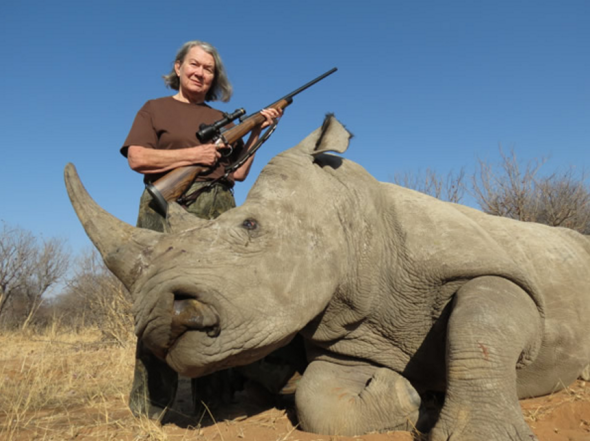
WHY ARE WE STILL HUNTING RHINO?
Why are foreign and native Africans still trophy hunting Rhinoceros for, when no amount of funding generated from these hunts has actively decreased poaching? Image credit: (Mrs Janice Hull, Limcroma South Africa).
Over five years ago I and a group of dangerous game hunters (DGH’s) were involved within a heated debate relating to the money allegedly generated from rhino hunting. The question I asked (and continue to ask) was: “Why are we still hunting rhino for when the money generated from these hunts doesn’t appear to be having any affect whatsoever on decreasing rhino poaching or increasing conservation efforts and security for African rhinos”? (Image above: Hunter - American Janice Hull).
The answer[s] I received were mixed opinions, abuse, and lies. I aimed this question at a number of professional hunters - (PH’s) working in South Africa, and Namibia most of which were American. While the vast majority of dangerous game hunters stated money raised from hunts was directed back into rhino conservation, I’m still after five years questioning where this money is actually going because rhino poaching is not decreasing whatsoever?
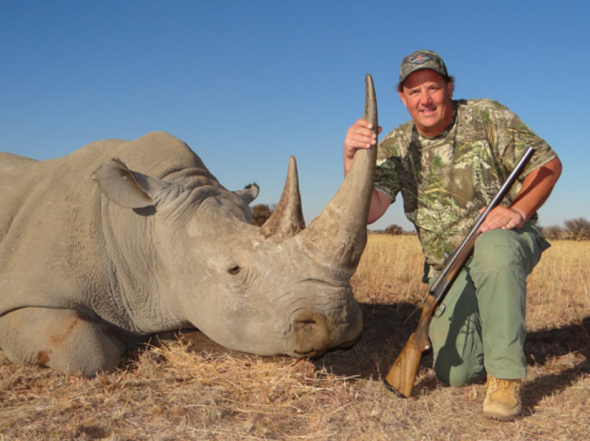
Image Credit: Trophy hunter Mr Loddie Naymola
Since 2008 poachers have slaughtered a staggering 5,940 Rhinoceros - most of which have been poached within South Africa’s flagship park identified as the Kruger National Park. From the year of 2007 rhino poaching figures began increasing rapidly. A total of 13 rhino were bludgeoned to death in 2007. Meanwhile in 2009 South Africa lost a further 122 rhinos (due to poaching).
However come 2011 we really began to see poaching figures rise, come the end of December 2011 a whopping 448 rhinos had been slaughtered by poachers to fuel the Asian demand for pseudo rhino horn medicine. Come 2013 figures shot through the roof resulting in some 1,003 rhinos poached stated the Department of Environmental Affairs come 2013 December end. Then the largest stats were reported back in 2014 of which South Africa lost some 1,215 Rhinoceros to poachers. Yet ‘hunting revenue is preserving our ionic species’?.
Unfortunately at some point from 2014-2016 the Department of Environmental Affairs Minster Honorable Edna Molewa placed a complete ban on the public reporting of any rhino poaching figures, there was no reason as to why this ban was implemented, of which to date still remains in place. Coincidentally (2015’s poaching statistics) had decreased somewhat - of which come December 2015 some 1,175 rhinos had ‘allegedly been poached’. Isn’t that coincidental, a blanket ban on poaching figures is ordered, then come the next year a decrease is seen!.
SOURCE: POACHING STATISTICS.
The SOUTH AFRICAN DEFENCE WEB stated back in January 2016 that a ‘lack of rhino poaching information was negatively affecting anti poaching’. However despite the governmental blackout on rhino poaching incidents numerous organisations such as ‘Stop Rhino Poaching and ‘Outraged South African Citizens against Poaching’ had reported via media, press and anti poaching reports a small rhino poaching decline.
However both of these organisations didn’t obtain their reports from the government, or did they?. So last years poaching stats could indeed be higher than what has been stated in the public domain. Furthermore both Facebook/Online groups/NGO’s share there statistics openly. So in all honesty there is no evidence whatsoever to prove a poaching decline from 2015 has occurred. Moreover and as explained - I myself find it awfully suspicious that since the 2015 poaching report blackout by the South African government - poaching stats just coincidentally decrease like that?.
Elise Daffue whom ‘allegedly runs some form of rhino intelligence group’ (on Facebook - identified as Stop Rhino Poaching), and not in the actual field, stated: “The drop in kills is testimony to the huge effort being made on the enforcement side. Environment Asset Protection strategies have been formulated and implemented over the past three years, guiding the strategic and operational plans nationally – from the ranger in the bush who detects the spoor to the prosecutor who fights that bail is denied. Keeping the numbers down depends entirely on good field work and reserve security, good investigations and good convictions”
While Elise Daffue has stated there was a drop in rhino poaching due to a “huge effort being made on the enforcement side” there remains no evidence whatsoever proving there has been a decline in rhino poaching from 2014-2015. Moreover if there is evidence where has this data come from?. Furthermore whenever we see hunters and ‘animal lovers mingling together’, regardless of what you state your organisation is and does - alarm bells begin ringing, especially coming close to the next CoP summit.
The Founder of Stop Rhino Poaching is friends with a hunter identified as Gustav Collins who runs the Mattaniah Game Reserve Furthermore Elise Daffue is also associated with the individual known as Simon James Naylor who is the Conservation Manager for Phinda Private Game Reserve of which has connections to various hunting organisations and the (WWF) that supports sustainable hunting of Rhinoceros within South Africa and Namibia. Finally (among many others) we have Mr Mark Lautenbach who works as a Specialist Freelance Guide at Ukuthula Lodge. Elise Daffue founder of Stop Rhino Poaching is also friends with a Department of Environmental Affairs worker, and numerous other governmental bodies, police and hunters.
While the above details may not seem overly important, when we’re trying to locate data on hunting statistics, money generated from these activities and more, suspicions are raised when we locate so called professional organisations that are connected to numerous hunting organisations; and institutions such as ‘petting farms’ I.e Ukutala Lodge that has connections with the canned hunting industry and, has featured in a (Blood Lion documentary).
So as one can see it all becomes rather confusing when all we want is upfront and honest answers, however when we ask questions and later find out there are numerous connections to the hunting and possibly ‘pseudo hunting trade’ will we even obtain a serious, straightforward and honest answer? When we’re lied to by hunters, how can we possibly trust Non-Governmental Organisations that are aligned to the very people whom are lying, and are hunting our rhinos while pretending to be so called conservationists? Moreover we (the organisation) do not believe there has been any decline whatsoever relating to rhino poaching. We do though believe that this so called ‘decline may be playing a role in this months CoP17 Summit’ relating to rhino horn legislation.
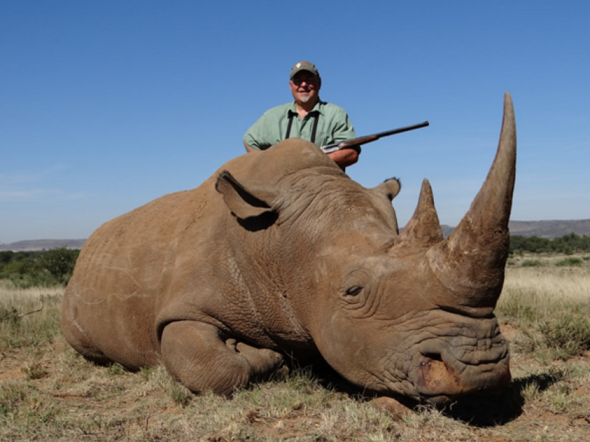
Image Credit: European trophy hunter, Mr Dennis Schemmel
Back in July 2016 it was reported that Rhinoceros poaching was finally without a doubt at ‘tipping point’. South Africa has seen the largest poaching rates recorded at some 72% from 2011-2015. Namibia recorded a loss of 10.8% from 2012-2015. Zimbabwe recorded a loss of 3.1% from 2012-2015. Kenya has recorded a loss of 4.4% from 2012-2015. Finally ‘other African range states mainly in Central Africa’ recorded a loss of 2.5% from 2012-2015.
While its been reported that some 25,000 Rhinoceros remain on the African continent - a depressing near six thousand have been poached all over the continent from 2012-2015. Yet hunting revenue from one of Africa’s most expensive game animals is allegedly reducing poaching? How is this possible, when we’ve lost so many rhinos, and reports from the Global Initiative have confirmed ‘rhinos are at tipping point’.? Furthermore how can the hunting community continue to state that revenue from rhino hunting is helping to secure the rhinos future when 1. It clearly isn’t due to poaching statistics increasing, and 2. The majority of hunters today are now supporting an international rhino horn trade ban lift?
The Global Initiative stated: “Dozens more rhino have been shot in so-called “pseudo-hunts”. Across Europe, castles and museums have been raided by criminal gangs in search of rhino horn trophies. And in the United States, businessmen, antique dealers – even a former rodeo star and a university professor – have been implicated in the illicit trade”. Driven by seemingly insatiable demand in Southeast Asia and China, rhino horn has become a black market commodity rivalling gold and platinum in value.
SOURCE: GLOBAL INITIATIVE.
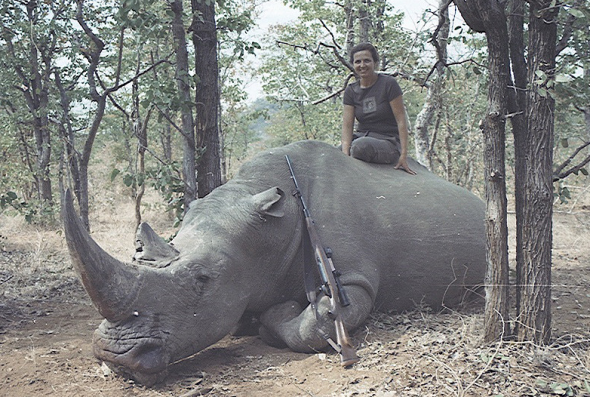
Image: Female rhino hunter, origin of hunter unknown and name. South Africa?
To date there has been very little forthcoming information in relation to revenue generated from African rhino hunts, and where exactly this hunting money is going. Furthermore with rhino poaching still increasing, and tipping points now recorded by ‘various trusted organisations’ the question must now be raised why are we still hunting Rhinoceros?
From the 1940’s tiger hunting was common among many international and local tourists in India. However so too was tiger poaching. It was alleged that revenue from tiger hunting was actually helping to preserve the tiger species and other mammals too. Unfortunately this turned out to be complete codswallop. Then in 1973, the Indian government finally under the orders of Prime Minister Indira Gandhi banned tiger hunting due to so many tigers being poached - and legally hunted at the same time. Had Prime Minister Indira Gandhi not instigated ‘Project Tiger’, the tiger would have gone extinct way back in the 1970’s.
SOURCE: PROJECT TIGER.
In the last 50 years the tiger population in Asia has plummeted from 100,000 to about 5,000. The number of tigers is dangerously low, and the conservation of the world’s remaining tigers is of global concern. Now, in this volume, 40 world authorities on tigers from Asia, Europe, and North America have summarized and identified the management, conservation, and research needs for this endangered species. Before Project Tiger was implemented tiger populations were being hammered. The same identical hunting and poaching behavior before Project Tiger can now be witnessed in Africa - primarily in South Africa where rhinos are also being hammered both by hunters, poachers and pseudo hunters. Does that ring alarm bells among the many FAKE NGO’S out there?
International Animal Rescue Foundation Africa undertook various searches relating to rhino hunting and revenue generated from these hunts within South Africa. What we found was from 2005-2015 a total of 330 ‘White Rhinoceros’ had been legally hunted from 2005-2015. The minimum hunting price was exactly $50,000(USD). While the maximum hunting price was exactly $150,000(USD). It was found that from 2005-2015 and based on the assumption these were (white rhino hunts only) and, taking into consideration the minimum price first. Revenue generated from rhino hunting at the price of $50,000(USD) resulted in an estimated total $181,500,000 million - that’s $181 million(USD) raised from hunting. Meanwhile, and taking into consideration the highest price (being $150,000(USD) a total of $554,500,000 million was generated.
While we cannot place these two equations together and provide a factual sum because we don’t know how many rhinos were legally hunted at each individual price, the sheer fact that millions of dollars has been generated from 2005-2015 should be enough to explain that something isn’t quite right here. Furthermore these figures are based on the assumption these were white rhino hunts,
MINIMUM HUNTING PRICE: 2005-2015 = $181,500,000 million(USD)
MAXIMUM HUNTING PRICE: 2005-2015 = $554,500,000 million(USD)
SOURCE: HUNTING REVENUE.
SOURCE: REPORT TROPHY HUNTING.
To date (and as you can see within the sourced links above) there still hasn’t been a single reliable report that confirms just how much money is being made from trophy hunting in South Africa. The only so called reliable report (which is about as reliable as a chocolate teapot) and, being the only report to surface thus far stated that $200 million(USD) was generated from the years of 2010-2011 (in regards to all South African trophy hunts)? Who number crunched these figures, who even dared to come up with such an absurd low revenue income? I would also like to remind hunting organisations, just because you don’t have to tell us what you’re making, we can contact other organisations/institutions, locate prices, we can phone and email. Eventually we’ll find the truth!
Now either our expert eyes and our mathematical friends are missing something here, or journalists media and the pro trade lobby are forgetting that despite hunting revenue being made pubic. Environmental Scientists can research CITES trophy hunting statistics, then locate the common maximum and minimum price, and the number of rhino trophy heads exported/imported. So as one can read above just from the years of (2005-2015 - millions was made just from Rhinoceros hunting). Moreover who ever came up with the 2010-2011 sum of $200 million USD clearly is missing a lot of money off here, and needs to undertake a mathematical course too?
Rhinoceros hunting is by far the biggest money maker within the hunting business (most of this money is made in South Africa which hosts the largest rhino populations on the planet). Furthermore it just seems too coincidental that from 2010-2011 literally every hunting organisation that’s promoting/advertising rhino hunts has mysteriously removed their prices.
Trophy hunting of rhino is strictly regulated. Every year a total of five (black rhino) can legally be hunted within each of Namibia and South Africa, which totals to a maximum of (ten) per year - five per country. Furthermore in South Africa and Namibia one white rhino can be hunted by one hunter per year - that’s one rhino per hunter every year. Unfortunately there remains no further hunting revenue and data from the years of 2014. Its been estimated by the National Geographic based on the United States Fish and Wildlife report that the United States imported a total of 328 white rhino trophies from South Africa from the years of 2005-2014. Meanwhile a total of 7 white rhino were hunted and subsequently imported to the United States from Namibia from the years of 2005-2014.
SOURCE: NAT GEO HUNTING DATA.
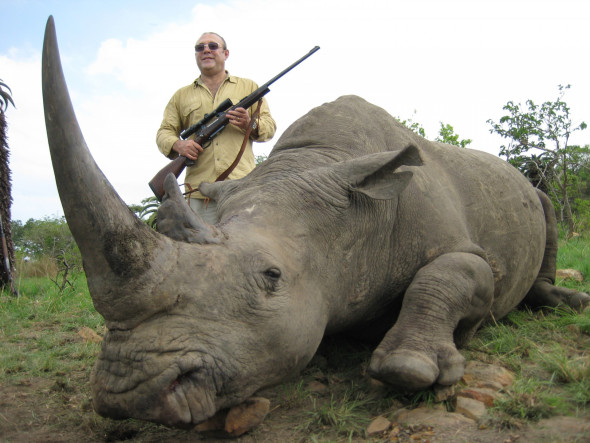
Image Credit: Rhino hunter Alexander Tseytlin
Black rhino hunts have provoked much controversy over the past five years mainly because black rhinos are actually listed as (critically endangered), hence why only five black rhinos can be hunted per year in South Africa and Namibia. Since 1996-2011 the species has been listed as near extinct on the International Union for the Conservation of Natures Red List. Fortunately due to ‘private farming conservation efforts (not wild efforts) the species has allegedly and gradually increased (primarily due to hunting?)’. Both private and wild populations are believed to be increasing within South Africa and Namibia placing the total species population count from 2010 at 4,880 black rhinos.
SOURCE: IUCN BLACK RHINO.
The only reports that we ourselves can offer in regards to black rhino trophy is that of media and press reports that have documented on large scale bidding for black rhino hunts. In January 2014, Corey Knowlton bid $350,000 for a permit to hunt and kill a black rhino in Namibia (Source: Corey Knowlton). Back in June 2016 Namibia offered up three of its black rhinos to trophy hunters. While the price has not been documented its most likely be in the region of just over $1 million(USD) for the three Black Rhinoceros (Source: Namibia black rhino hunt).
Meanwhile back in 1996 a game rancher named John Hume paid about $200,000 for three pairs of endangered black rhinos from the wildlife department of the South African province of KwaZulu-Natal. Among them was a male who would come to be called “Number 65,” and whose death would play a central role in the debate about conservation.
When the black rhino bull arrived, Hume’s farm manager — a burly Zimbabwean named Geoff York whose typical mode of dress is army boots and a pair of purple shorts — tranquilized him, clipped two notches in his left ear and two in the right, and gave him a number: 65. Mr John Hume later picked Mr Peter Thormahlen to organize the killing of ‘number 65’. The price was set at a $25,000 deposit on a $150,000 fee for a seven-day hunt.
Most of that would go to John Hume - the very man that is today advocating for an international legalized trade in rhino horn and has connections to a wide number of organisations such as, WWF, IUCN, CITES, The Department of Environmental Affairs and numerous other figures. Then on July 23rd 2005 Thormahlen and his client with John Hume tagging along proceeded on foot. Suddenly the rhino noticed them and rose from the dirt. The client pulled the trigger, and the first bullet pierced Number 65’s skull. The rhino, still standing, turned. A second bullet hit, and the rhino dropped dead. (Source: John Hume Rhino Hunt).
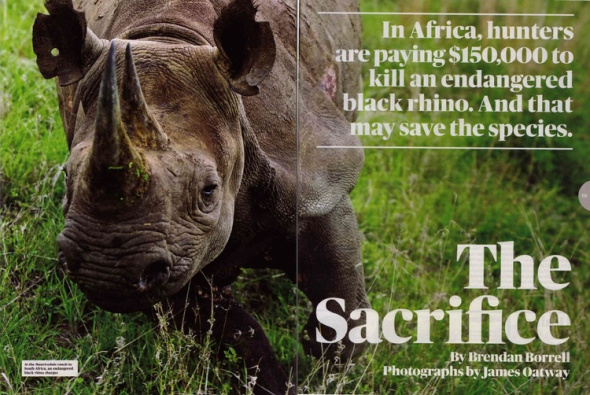
Source: The Sacrifice, please click the source tag for more info
As you can read there is a staggering amount of money parting hands to hunt both black and white rhino. Yet poaching is still skyrocketing? South Africa has lost from 2008 almost 6,000 rhinos to poachers. Back in 2014 Namibia lost a total of 24 rhinos to poaching, then come 2015 a whopping 60 rhinos were poached. (Source: Poaching stats Namibia).
So the question still remains just what exactly is all this money going towards, can each professional hunting organisation prove to me, my organisation and the public that the money generated from rhino hunting is indeed being used to fund anti poaching operations, security, conservation, education, awareness and horn poisoning? (Etc).
While I’ve been extremely silent on this issue too since 2011 I’m going to make it pubic now. I dislike the fact that a ‘prominent South African game hunter’ is involved with the Rhino Orphanage. Back in 2011 we (the organisation) were going to submit funding for scales and equipment, however when running a trace on whom ran the main website, down to a trace on that individuals Facebook page, and more we later discovered a ‘silent partner’ that is hunting many of the big five..
..So who do we trust when it comes to facts and figures? How can we trust anyone that is stating hunting is indeed increasing rhino numbers when literally every individual and organisation are in someway aligned to one another in South Africa and over the borders? Can the Rhino Orphanage and its ‘affiliate’s’ also prove that every single rhino that’s been saved has been released back into a reserve, and not hunted for sport that clearly from this entire document has proved - no amount of hunting whatsoever is increasing rhino populations!
Hunting operations are indeed expensive. While the price of a hunt may indeed seem high. One also has to take into consideration what the farmer and/or professional hunter has to pay for too. Upkeep of land, maintenance of vehicles and buildings, fuel, service charges for gas, electricity, water, and rent Etc, food and beverages for the visiting hunters, guest house uses, damages to guest houses, travel, firearms (among many other bills). Then of course comes anti poaching being the last bill. Some of this expense can be viewed below.
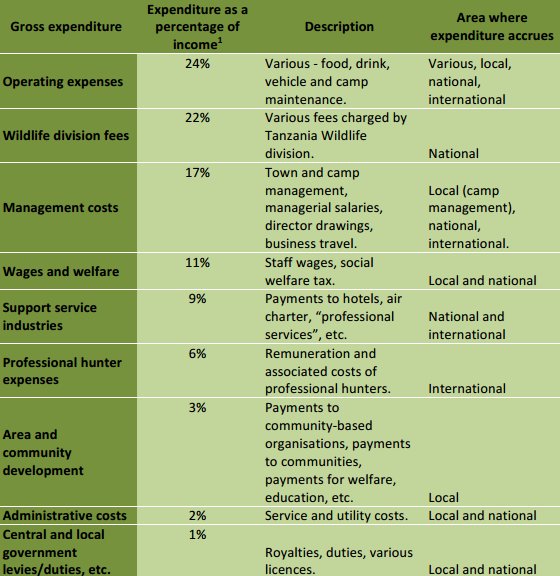
Image: Hunting Charges (Source: IFAW)
While we know that Rhinoceros trophy hunting is indeed expensive, poaching is unfortunately still increasing in various African countries, please do check the sourced links out above, and read that data carefully. The image above with source proves that no big five farmer is taking every single dollar or euro that’s advertises rhino hunting on their site or allows rhino hunting on their property.
So the question remains why are we still hunting rhino for? The question I’ve answered. Rhino hunting is nothing more than a overpaid sport that does nothing whatsoever for conservation and, is not under any circumstances whatsoever contributing to decreasing poaching. All these millions if not billions being made yet here we are still seeing rhinos poached. Finally, and the very best question of them all. If hunting revenue from rhino hunts is not decreasing poaching, how the hell is a so called sustainable rhino horn trade going to decrease poaching? Same money - same prices - going nowhere!
Thank you for reading.
Dr Jose C. Depre PhD. MEnvSc. BSc(Hons) Botany, PhD(NeuroSci) D.V.M.
Master of Environmental, Botanical & Human Science.
Environmental, Botanical and Human Scientist.
MASSACRE IN MOROCCO.
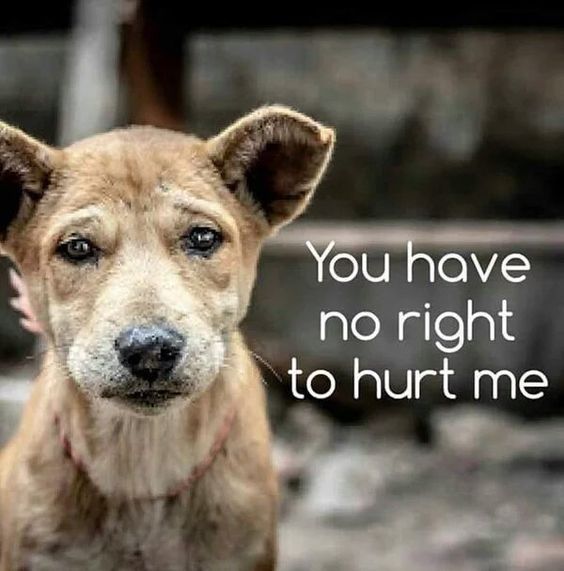
MASSACRE IN MOROCCO
From December 2015 to March 2016 Moroccan governmental officials within the city of Ksar el-Kebir have slaughtered many thousands of stray dogs with single or multiple shots to the head and body using live rounds. Some media and press reports have stated that the slaughter only went on for one day during December 2016, others state two days.
Fortunately International Animal Rescue Foundation Africa hosts a total of eighteen environmental activists within the African country, all of which have confirmed the slaughter has been ongoing from December 2015 and, is still ongoing today September 2016. However for now the cull is mostly over.
The nighttime killings have decreased significantly since the media began publishing on the mass culling of stray dogs and cats, and partially due to many street dogs now wiped clean off the streets of Ksar el-Kebir and within other Moroccan cities such as the Medina quarter - until next year of course.
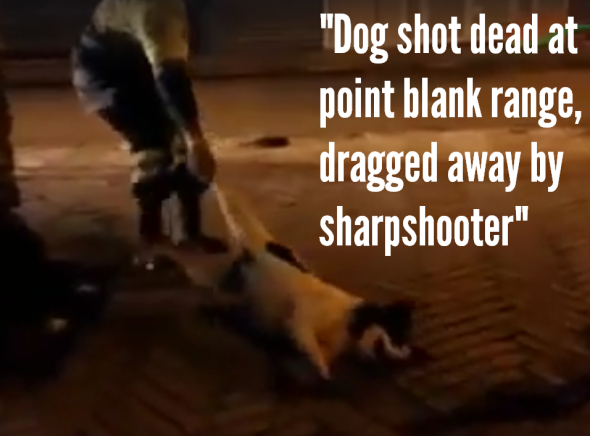
Image: One of many dogs killed by men gunmen.
International Animal Rescue Foundation Africa has learnt that the French Government in Europe are partially supporting the annual culling operation identified as ‘Street Animal Welfare’, although there doesn’t seem to be much in the way of welfare practiced here.
Sources have explained to us that most if not all of the local street dogs were shot using live rounds by inexperienced gunmen on the back of jeeps or 4×4’s. Moreover sources within the Moroccan capital of Rabat stated that poisons had been laid down to kill street dogs and cats too. The deaths were reported as horrific and nowhere near humane!
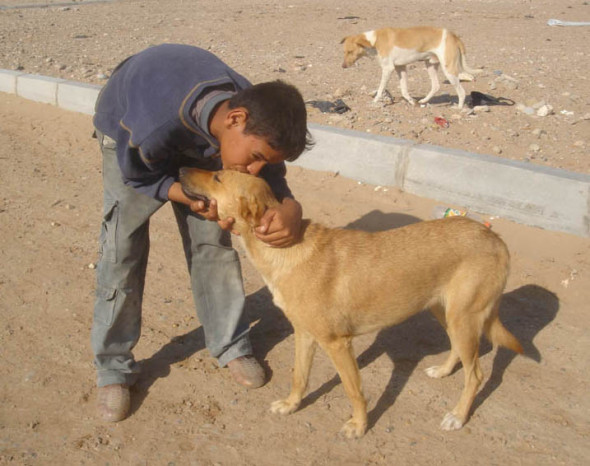
Image: Moroccan teenager showing love and compassion to a stray dog.
From December to date most of the killings have occurred at night which is when the vast majority of street dogs are active. (I.A.R.F.A) learnt that the Moroccan Government ordered the killings due to concerns of ‘rabies’ within the country, and because of an influx of tourists this year too. The Rabat capital ordered dog wardens to pin posters up relating to rabies, as well as hand them out to the locals (as can be seen below).
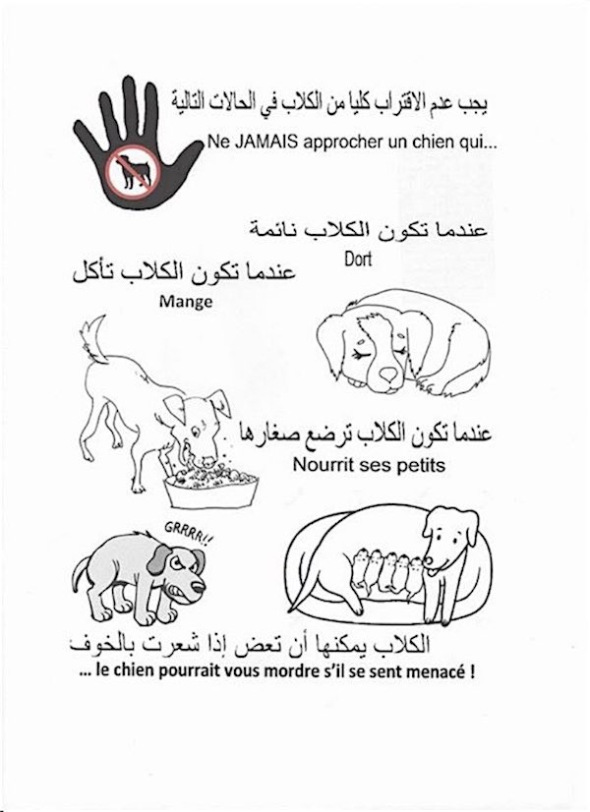
Image: Rabies info in French and Arabic.
The Ksar El Kebir Government ordered this years killings on the 22nd March 2016, although there is much evidence to show the killings began in December 2015. Nonetheless many dogs were slaughtered this year prompting the global population of animal lovers to kick up a wild frenzy, and why should’t they? Morocco isn’t learning here from its mistakes, instead every year they order inexperienced gunmen at nighttime to shoot hundreds of dogs a night (during the dated culling period).

Image: Dead dogs dumped onto the back of a 4×4 in Morocco.
Local authorities, in an ironic attempt to curb the number of starving canines, are sought to kill dogs, adults and puppies alike. These actions are as inhuman as they are expensive for the taxpayers. What’s more, there are numerous studies and expert assessments available from the best international specialists in public health, which demonstrate that this approach is totally inefficient. However despite the best efforts of everyone trying to halt this massacre - the bloody slaughter continued.
Its been estimated that in the Moroccan town of Casablanca, some 15,000+ street dogs are killed every-year. So one would kind of think that instead of killing stray dogs the authorities would at least try to humanly control the increasing stray dog population and, slow any rabies virus from emerging, seemingly not, every year more and more dogs are massacred in the most brutal and barbaric manners you could think of.
Morocco is a predominantly French Muslim/Muslim/Islamic African country of which the Holy Quran states the following in relation to animals that share the same quarters as us, socialize with us, and roam with us (Etc.):
“There is not an animal (that lives) on the Earth, nor a being that flies on its wings, but (forms part of) communities, like you.” (Sura 13 Aya 15).
Furthermore another interesting quote from the Holy Quran is that about ‘mistreatment of animals’. The Holy Quran states the following:
“It is related from Jabir that the Messenger of Allah, once saw a donkey which had been branded on its face and he said, “May Allah curse the one who branded it.” (Muslim)”
While I’m not going to become embroiled within some religious debate, I do find it grossly contradictory that so called ‘Muslims that follow the holy scriptures of the Quran would then violate that holy book or anyone of the alleged recited peaceful verses’?
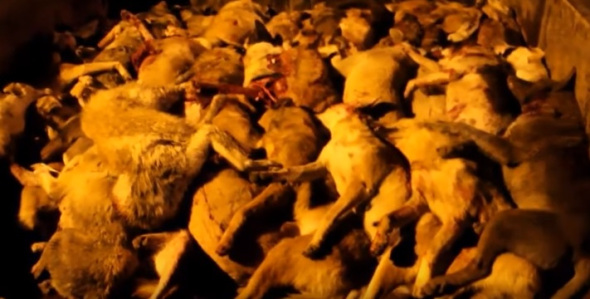
Image: Hundreds of dogs shot dead violating the Quran’s scripture.
The majority of the killings took place in Ksar-el-kebir of which some 110,000 people inhabit. Furthermore about 160km’s away from ksar-el-kebir in Rabut public workers took to the streets killing more dogs.
Further, in Marrakech, local city authorities opted for the poisoning as procedure. Same for Salé, Skhirat Kenitra [Rabat-Salé-Kenitra] and Nador [Oriental Region] says Loubna El Mourabite Kettani, a militant of the animal cause, adding that poisoning can affect even the dogs that have owners, as the poisoned bait is scattered randomly in neighborhoods.
International Animal Rescue Foundation Africa, The World Health Organisation, International Fund for Animal Welfare, and the International Alliance for Rabies Control ‘strictly advises’ local authorities worldwide to sterilize and vaccinate dogs in order to reduce their population and combat rabies. However as you can see every year throughout various Moroccan cites and towns the local authorities opt for killing dogs at point blank range, with live rounds or just poison baits, however things may be on the turn (please keep reading).
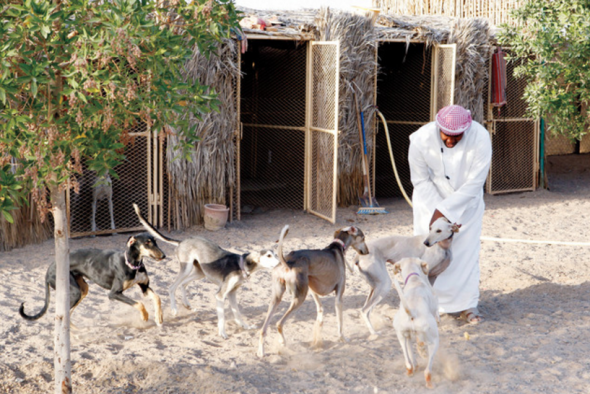
Image: Muslim’s do love dogs, sadly ‘a minority don’t’.
Zineb Bouchikhi, ONSSA’s communications officer, said that: “stray dogs that do not have owners, given the danger they pose to public health, are eliminated by local authorities as part of the national strategy against rabies. Dogs which have owners, in turn, are vaccinated annually by ONSSA officers in rural and peri-urban areas. In urban areas, private veterinarians are in charge of this operation.”
In the period from 2010 to 2015, an average of 90 000 owned dogs were vaccinated by the veterinary services of ONSSA in different regions of Morocco. However, there are no statistics on stray dogs slaughtered by local authorities each year. (How coincidental is that?).
International Animal Rescue Foundation Africa, local and international charitable organisations believe in capture, vaccinate, sterilize, de-worm and relax in the area of origin, is the best scientific, ethical and sustainable approach to preserve human and animal health. Shooting dogs though is not controlling the problem which is clear to see due to annual shootings every year.
Furthermore the cost of shooting dogs will heavily outweigh the cost of vaccination. Concerning-ly due to the press and media picking up on these mass and brutally horrific culls it will only bring a bad name to Morocco thus reducing tourism, finance, increasing poverty, unemployment and crime.
Trap: (Trap, neuter and release) is practiced in India, Turkey, America and Canada and has enabled eradication of rabies in a few years. In Morocco, including Essaouira and Taghazout, similar experiments were carried out. These are examples to generalize nationally. So if (TNR) works why are the local authorities still shooting dogs dead at some 15,000-25,000 a year annually?
Half of the domestic dogs and strays stay in residential areas, close to the forest or the sea. Meanwhile they rule the streets in the night finding food near the garbage containers or outside houses in the suburbs. In the early morning they leave to find a more calm place to sleep, usually in the forest. Strays mostly shy away from humans who use to throw stones at them as a protection.
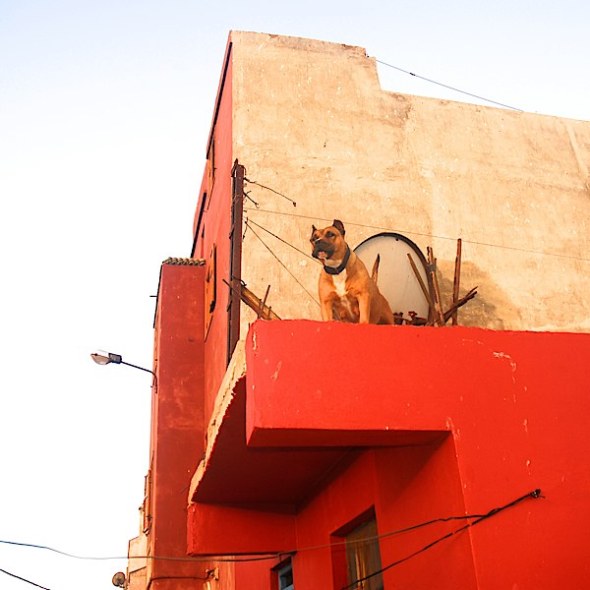
Image: A watch dog in Sekkala.
Concluding I can state now: An initiative has been launched as of [Wed 30 Mar 2016] in Rabat jointly by RAPAD and Adan association in collaboration with municipal councilors of Rabat for the creation of a pilot project for the benefit of canine and feline stray populations. The associations of the capital [Rabat] aspire to make it a successful alternative experience to convince both the state government departments and elected officials to abandon slaughter.
For now though I’ll leave you with this video as a shocking reminder to the ongoing crisis in the African country of Morocco. We (the organisation) hope to never see such a sickening image of barbaric brutality again.
Dr Jose Carlos Depre
Chief Executive Officer | Director
BROCCOLI & QUINOA BREAKFAST PATTIES | VEGAN MONDAY #TRYVEGAN ©

BROCCOLI & QUINOA BREAKFAST PATTIES | VEGAN MONDAY #TRYVEGAN©
Good morning world, and welcome to another #TryVegan recipe. Every Monday and Friday we release on this news site to hundreds and thousands of readers, and many more subscribers (around the globe) a ‘Try Vegan recipe’ Furthermore every day we also release a vegan and/or vegetarian recipe via our main Facebook page hereto: TRY VEGGIE OR VEGAN. Monday and Friday’s vegan recipes are aimed at those that are still wanting to try, but unsure, so why not dedicate two days of the week where you’re meat and dairy free for two of them days?
As we explain every week all recipes are aimed at everyone. We covert recipes from our readers, we share recipes from third parties, and we also make our own recipes. (Stay tuned for the new and tasty French Fries - you’ll be gagging for more). Moreover NO animal died in the making of any recipe that is 100% vegan. Anyway lets crack on.
Broccoli is probably not something you’d imagine ever eating for breakfast. However if that simple yet crucial healthy green vegetable is mixed with other plant based materials and served up with refreshing drinks you’ll never know. Did you know: Broccoli actually helps to ‘fight off cancer cells’ however it doesn’t cure cancer, nor has it ever cured any cancerous illness that I am aware of. If it helps to prevent cancers though from forming, then get it down you fast.
INGREDIENTS:
2 Garlic cloves
1 1/2 tsp Garlic powder
1 handful Green onions
1 cup Mixture of broccoli and carrots
1 1/2 tsp Onion powder
2 tsp Parsley
1 Parsley
Refrigerated
2 Flax eggs
Canned goods
1/2 Vegetable bouillon
2 cups Vegetable broth, low sodium
1 Vegan sour cream
1 cup Quinoa, cooked
1 Salt and pepper
2 tbsp Coconut oil or extra virgin olive oil
1/2 cup Bread crumbs, gluten free
“THAT’S AL YOU NEED”
RECIPE:
Rinse quinoa thoroughly then place in a sauce pan with 2 cups of low sodium vegetable broth and 1/2 vegetable bouillon (optional). Once it reaches a boil, reduce heat, and let simmer for 15 minutes. The quinoa will absorb all the broth. In a large bowl add 1 cup quinoa, shredded broccoli and carrots, flax eggs, bread crumbs, garlic, parsley, 2 tbsp of oil, and salt and pepper to taste, mix until well combined. Drizzle a little coconut oil or extra virgin olive oil over a fry pan. Make palm size balls out of the mixture. Place on fry pan and flatten with a spatula. Cook on both sides 2-3 minutes or until crisp golden brown then place on a plate lined with a paper towel to catch any oil drippings. Do not over saturate with oil. Once cooked enjoy right away and top with vegan sour cream and parsley.
Store in an airtight container, will last in the fridge for up to 5 days, maybe a little longer. Enjoy!
“SOMETHING GOOD TO DRINK MAYBE?”
As with all healthy breakfasts its always good to have a health drink too (with plenty of clear water). While we do like to advocate for non-dairy I myself have noticed among many vegan recipes there is an awful amount of water missing. Water is an incredibly important fluid for humans - and without it you die, simple as. I myself drink over 3.4 liters of water everyday and have done for years. You’ll know when you’re hydrated because your urine will be clear and non-smelly (that’s a good sign).
Dehydration is a leading cause for many diseases, infections, bowel problems and even serious illnesses forming. Furthermore a significantly low water intake can affect your concentration, reduce your alertness, increase irritability, mood swings, and has even been proven in students to lower their grade results. Why though?
Basically your brain needs water, to be precise your body and brain needs at least 2.6 liters of [clear water] every single day. Students trialed with a low water intake were shown to have poor exam results. Students trialed with a good water intake were proven to have near top grades. Water increases your brain function, wards of tiredness, water is so damn good for you - many of us still fail to drink enough. I find that strange.
You know many armed forces combatants that used to present themselves to me with common illnesses I’d allow them to speak then send them off, my simple order was please drink for 48 hours up to and over NOTHING BUT CLEAR WATER. You may find this difficult to digest but your immune system needs water to fend off bugs. Without it you’ll be coming down with bug after bug. Over a decade ago I read a book from an imprisoned general practitioner in Asia. He was a Human Rights Activist. Furthermore he was also a (GP).
Unfortunately he had all of his medicines removed from him, when sent to prison. Within his cell were a number of men that were suffering from serious ulcers and illnesses. Dr Batmanghelidj cleaned the ulcers with water that the guards provided to him, and asked the men to drink water every few hour until the infections cleared up until they were 100% hydrated.
The ulcers cleared up in under one week!. Meanwhile the other men that were presenting themselves to Dr Batmanghelidj were all exhibiting common and some serious illnesses. Dr Batmanghelidj later found out that them men were all being denied water. Once provided with water their symptoms and illnesses went away. You can read Dr Batmanghelidj’s book here and please do purchase it. There are no magical cures for cancers, or other ‘serious illnesses’. However a good intake of water actually increases one good thing in your body - being that of your immune system.
“ONCE YOUR IMMUNE SYSTEM IS IN WORKING ORDER - SO ARE YOU”
“THAT’S BASIC AND STRAIGHT FORWARD MEDICINE WITHOUT THE MED’S”
BREAKFAST HEALTH SHAKE
This recipe was submitted to myself from a wonderful woman that’s actually incredibly healthy. Could it be the water? The shake is called the ‘MEAN GREEN’ and its filled with many antioxidants too.
INGREDIENTS:
1 stick of Celery
Half a Cucumber
1 half of a Lemon
1 handful of Spinach
1 handful of cos Lettuce
1 Pear (skin included), 3-4 rings of pineapple
1 big cup of CLEAR water and just a handful of ice cubes
Add to this a teaspoon of flax seeds
RECIPE:
Take all your prepared ingredients above, add them to a blender, and blitz for about twenty seconds or until the mixture is smooth. Please note when adding ice cubes you may need to blend for a little longer, and shake the blender about a bit depending on the size of the ice cubes.
That’s it folks. Your morning breakfast and drink has been written - now all you need to do is make it, serve, and consume.
Have a nice day and, don’t forget to check the video out below ON WATER!
Dr Jose C. Depre PhD. MEnvSc. BSc(Hons) Botany, PhD(NeuroSci) D.V.M.
Master of Environmental, Botanical & Human Science.
ENDANGERED SPECIES MONDAY | SUNDASCIURUS HIPPURUS
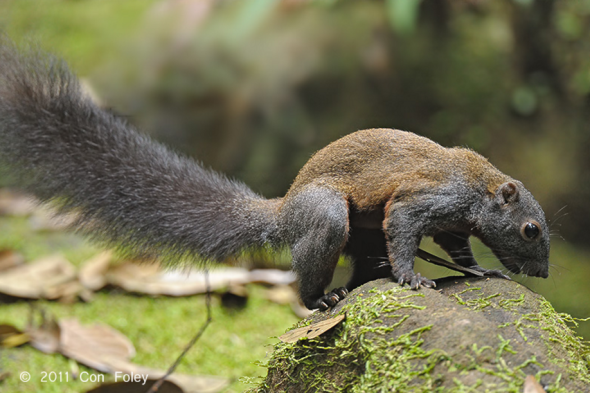
ENDANGERED SPECIES MONDAY | SUNDASCIURUS HIPPURUS
This Mondays (E.S.P) post - [Endangered Species watch Post] I am documenting on the horse tailed squirrel, scientifically identified as Sundasciurus hippurus. (Image: Horse tailed squirrel. Credits: Con Foley)
Listed as [near threatened] the species was first discovered back in 1831 by French Dr Étienne Geoffroy Saint-Hilaire (15 April 1772 – 19 June 1844) who was a French naturalist who established the principle of “unity of composition”. He was a colleague of Jean-Baptiste Lamarck and expanded and defended Lamarck’s evolutionary theories.
Geoffroy’s scientific views had a transcendental flavor (unlike Lamarck’s materialistic views) and were similar to those of German morphologists like Lorenz Oken. He believed in the underlying unity of organismal design, and the possibility of the transmutation of species in time, amassing evidence for his claims through research in comparative anatomy, paleontology, and embryology.
Dr Geoffroy ‘allegedly’ named the squirrel ‘the horse tailed squirrel’ because the squirrels tail resembled that of a horse tail, although even I myself find that somewhat difficult to digest, as in all due honesty the tail looks more like a bushy tail, which horses don’t really host. Horses tend to have long, slender and non-bushy tails, while others do host a type of busy but lose tail. I could be wrong?!
While as yet I cannot prove this, I do believe that Dr Geoffroy may have named the squirrel after a wild dwarf Asiatic horse endemic to South East Asia - that as yet we environmentalists have as yet to discover more about, furthermore that species of horse is likely to be extinct.
Moving on and (as explained) the horse tailed squirrel has been listed as [near threatened]. From 1996-2012 the species was placed into the category of [lower risk/least concern]. Lower risk/least concern is defined as: A taxon is Least Concern when it has been evaluated against the criteria and does not qualify for Critically Endangered, Endangered, Vulnerable or Near Threatened. Widespread and abundant taxa are included in this category.
International Animal Rescue Foundation Asian Environmental Scientists have been studying this species (among others) and can confirm from camera traps that the mammal’s populations are still declining significantly. However to what extent we’re still unsure.
As yet there have been ‘no reported extinctions’ within anyone of the species endemic countries being: Brunei Darussalam; Indonesia (Kalimantan, Sumatera); Malaysia (Peninsular Malaysia, Sabah, Sarawak) and Thailand. Since 2012 environmental fauna scientists have tried in vain to establish a mean population count, unfortunately as yet we (the organisation) and non-related organisations cannot determine a true population count.
Back in 2004 Dr’s Han and Giman pers. comm stated that the species was common, furthermore there was no evidence to prove the species was severely fragmented, or nearing endangered. The species prefers to inhabits lowland forests, however is also located in secondary forests too. Scientists reported that within these secondary forests species populations were on the decline.
Unlike your normal European squirrel the species can commonly be located at ground level foraging for food ranging from nuts, fruits, seeds and insects. Interestingly the species is diurnal (again unlike the European squirrel). Diurnal means the species will be active either during the day or night. Whereas the European squirrel is normally pretty active during the daytime, then rests during the night.
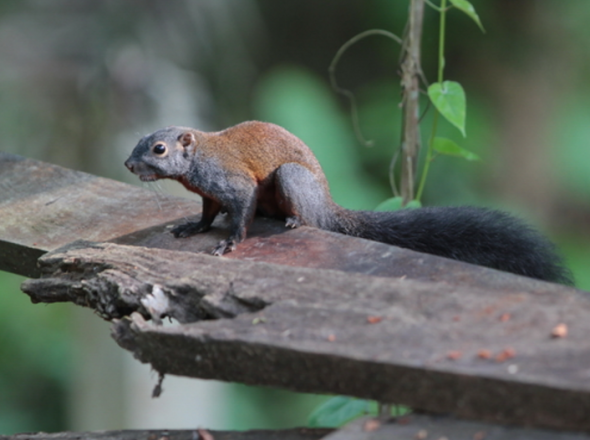
Image: Horse tailed squirrel: Photographer unknown
While the species ‘often lives within the trees’, horse tailed squirrels will spend a majority of their time at ground level. It has been suggested that one of the reasons for low densities of this species in Malaysian tropical rain forest is competition from the great variety of other arboreal vertebrates (such as birds, and especially primates) for food, especially fruits and leaves, which are among the food items preferred by squirrels.
There are by few very few threats actually known, however don’t take that as positive news. The species is threatened by habitat loss due to logging and agricultural conversion. I expect the first extinctions are likely to be witnessed within Malaysia (based on past and current research). Malaysian deforestation and palm oil plantations all pose a very high threat to the horse tailed squirrel as well as many other species of flora and fauna.
Nearly 60% of Malaysia is still covered with natural rain forest, unfortunately much of Malaysia forests are devoted to cash crop plantations, particularly oil palm and rubber, with tree crops occupying 17% of Malaysia’s land area. These are ideally suited to Malaysia’s hot, wet, and humid climate.
While many of us are aware of ‘palm oil devastation’ which is probably by far the biggest threat to a wide number of animals and plants - including the horse tailed squirrel. I would also like to point out to many non-meat and dairy consumers (I.e: Vegans), that while coconut plantations are for now considerably small. These plantations are still being developed and farmed within areas that once saw pristine green forests - now nothing more than a brown churned up heap of land growing and harvesting coconuts too.
In Malaysia, coconut is the fourth important industrial crop after oil palm, rubber and paddy in terms of total planted area. It is also one of the oldest agro-based industries. As an industry, coconut contributes very little to the overall economy of Malaysia (contribution to export earnings of about 0.08% in 2006).
Recent competition with oil palm for land has also resulted in the decline of the total area under coconut cultivation: in 2001, the area was about 151,000 ha and this has gradually decreased to the acreage of 109,185 ha in 2007. Based on the estimates given under the 9th Malaysia Plan, it is anticipated that the acreage will consolidate to around 80,000 ha by 2010. However regardless of this ‘alleged decline’ most if not all coconut plantations are farmed within forests where species such as the horse tailed squirrel is inhabiting.
The species is found in several protected areas, including Pasoh Forest Reserve. Environmentalists state the need for further comparative study on this species’ abundance, density and distribution and its relationship to forest structure or habitat quality, spatially and temporally, in hill dipterocarp forest of Malaysia is greatly needed.
For now the future of the horse tailed squirrel is uncertain. I’m doubtful the species will remain extant within Malaysia for much longer - with possible localized extinctions witnessed here soon. More research needs to be undertaken on the species, furthermore we also need to research just how much ‘pristine green forest is being converted for fruit, cereal crops, oils and plant milk crops’ rather than just palm oil. While I find palm oil agriculture incredibly concerning. Knowing that anyone of our vegan, vegetable and fruit crops is originating from areas where animals are being killed - is just as concerning too.
Thank you for reading.
Dr Jose C. Depre PhD. MEnvSc. BSc(Hons) Botany, PhD(NeuroSci) D.V.M.
Master of Environmental Botanical & Human Science.
(Environmental, Botanical & Human Scientist).
FRENCH TOFU QUICHE | VEGAN VENDREDI #TRYVEGAN.

FRENCH TOFU QUICHE | VEGAN FRIDAY #TRYVEGAN
This Friday’s vegan recipe is now out, and what a good way to end the week off with a French tofu quiche, and of course a nice Ampelidae 2012 Marigny-neuf Chardonnay (vegan friendly wine).
For those of you that may be new to our news-site, every Monday and Friday we host to hundreds of thousands of people around the globe a #TryVegan recipe. Meanwhile on our main Facebook page: Vegan and Vegetarian Foods to Promote Healthy Living we host every single day a vegan and/or vegetarian recipe that’s aimed at thousands of readers worldwide.
A few weeks a go we ditched the ‘go vegan’ hashtag as personally we believe this is demanding. We believe in encouraging people to ‘try vegan or vegetarian recipes’ rather than pushing our own beliefs down other peoples throats. We’ve listened to hundreds and thousands of our supporters over the years that dislike this form of education.
Furthermore we’ve also changed many of the recipes that we produce from things such as bowls or plates of just green vegetables - to mouthwatering, and tantalizing recipes for all the family. We’re producing soaps, liquid soaps, aromas, educating and will soon be hosting our live healthy eating channel - that is 100% non-animal harm. How cool is that!?
Okay so lets begin. The following recipe is French, the ingredients are easy to purchase from your local food store, although the wine you may need to order from a specialist or online. Should you experience any problems please do get back to one of the admins via the main link above. Apart from that have a great weekend, and don’t forget to check the video out below for a quick and simple sweet to go with your dinner too.
INGREDIENTS:
CRUST
~3 medium-large potatoes (3 cups grated)
2 Tbsp melted vegan butter (or sub olive oil with varied results)
1/4 tsp sea salt and cracked black pepper
FILLING
12.3 ounces extra firm silken tofu, patted dry
2 Tbsp nutritional yeast
3 Tbsp hummus
Sea salt and cracked black pepper (to taste)
3 1/2 garlic cloves, chopped
2 leeks, thinly sliced and thoroughly cleaned and dried (or sub 1 medium onion, diced)
3/4 cup cherry tomatoes, halved
1 cup chopped broccoli
RECIPE:
Preheat oven to 450 degrees F and lightly spritz a 9.5 inch pie pan with non-stick spray. Grate potatoes and measure out 3 cups. Then transfer to a clean towel and firmly squeeze out excess moisture. Add to pie dish and drizzle with melted vegan butter and 1/4 tsp each salt and pepper. Toss to coat, then use fingers press into the pan and up the sides to form an even layer. Bake for 22-27 minutes or until golden brown all over. Set aside. While crust is baking, prep veggies and garlic and add to a baking sheet. Toss with 2 Tbsp olive oil and a healthy pinch each salt and pepper and toss to coat. Place in the 450 degree oven with the crust. When you take out the crust, lower heat to 400 and continue baking until soft and golden brown (a total of 20-30 minutes). Set aside and lower oven heat to 375 degrees.
To prepare tofu filling, add drained tofu to a food processor with nutritional yeast, hummus, and a heaping 1/4 tsp each sea salt and black pepper. Set aside. Remove veggies from oven, add to a mixing bowl and top with the tofu mixture. Toss to coat, then add to the crust and spread into an even layer. Bake quiche at 375 degrees for a total of 30–40 minutes or until then top appears golden brown and firm. If the crust begins to get too brown, loosely tent the edges with foil. Let cool briefly and then serve with fresh herbs or green onion. Store leftovers loosely covered in the fridge for up to two days. Reheat in the microwave or in a 350 oven.
“Bon appétit”
Don’t forget to serve with a nice vegan French wine. You should today be able to locate a good wine seller that is trading in both vegan and non-vegan wines. Try to shop at a wine merchants, rather than a grocery store as you’ll most likely not locate a single vegan wine at all. Wine merchants are always best. Finally if you’re looking to impress the friends and family or just yourself and partner, then please do check the vegan French sweet out below via the video. Enjoy your weekend.
Dr Jose C. Depre - PhD. MEnvSc. BSc(Hons) Botany, PhD(NeuroSci) D.V.M.
Master of Environmental, Botanical & Human Science.


